Startseite > Exhibitions > Past temporary exhibitions
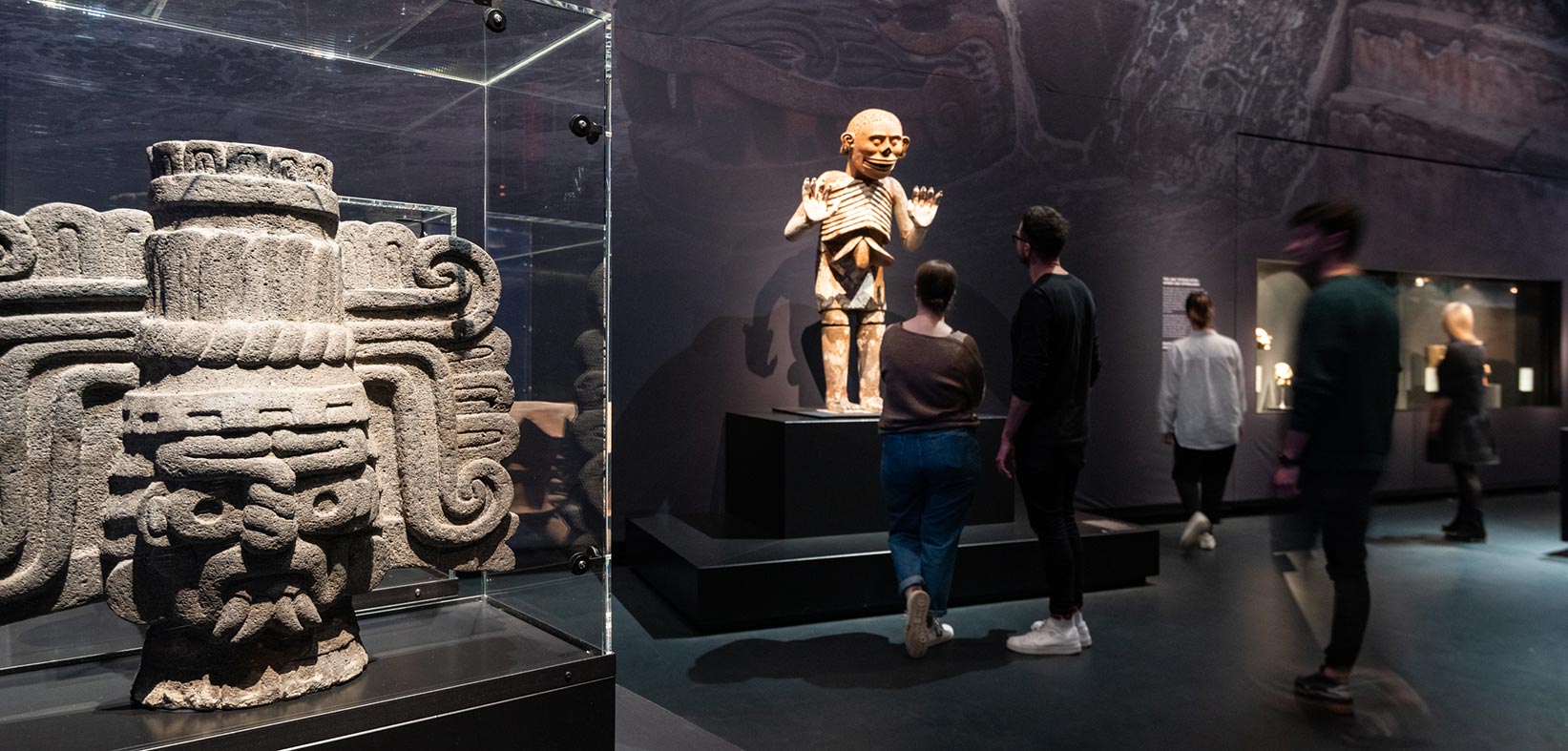

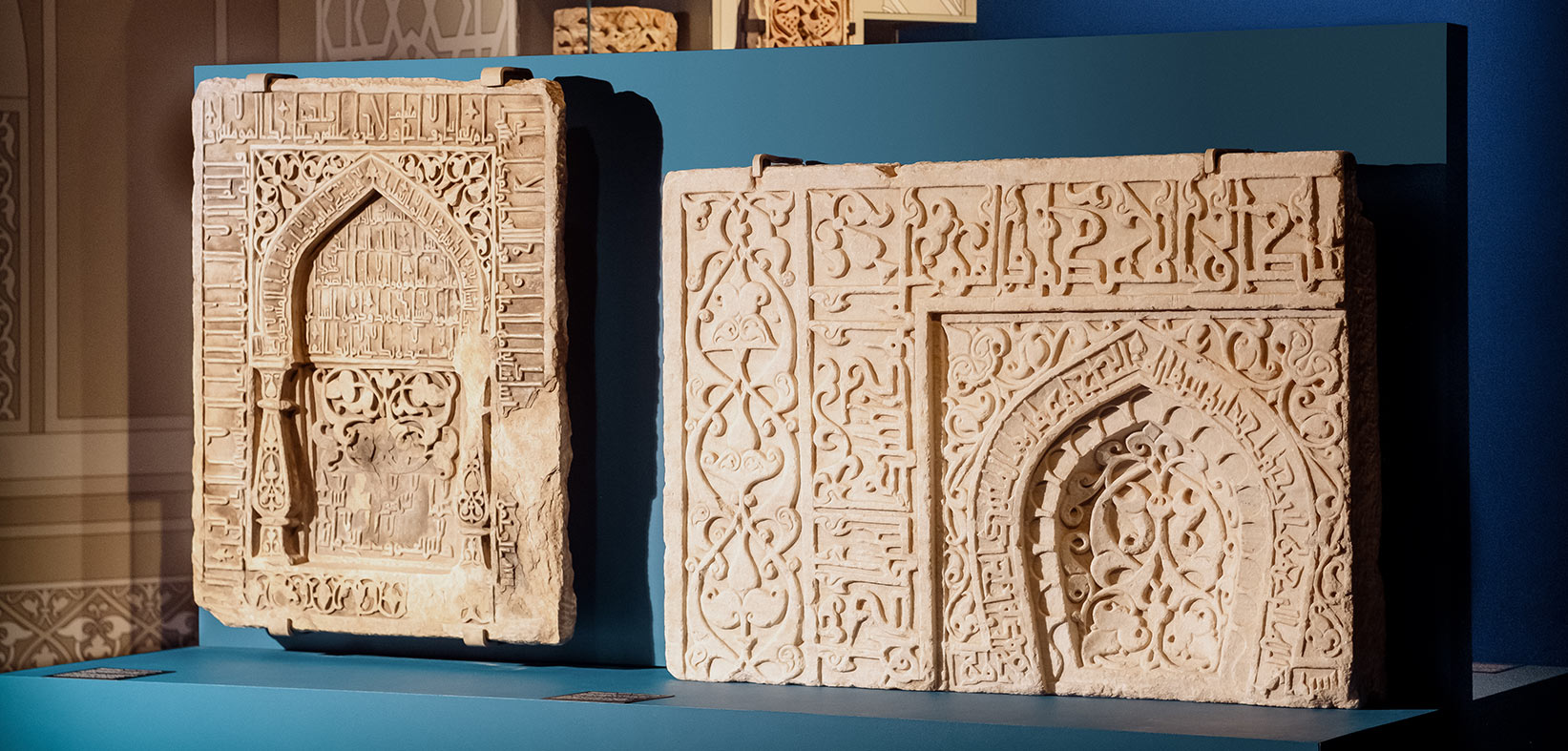
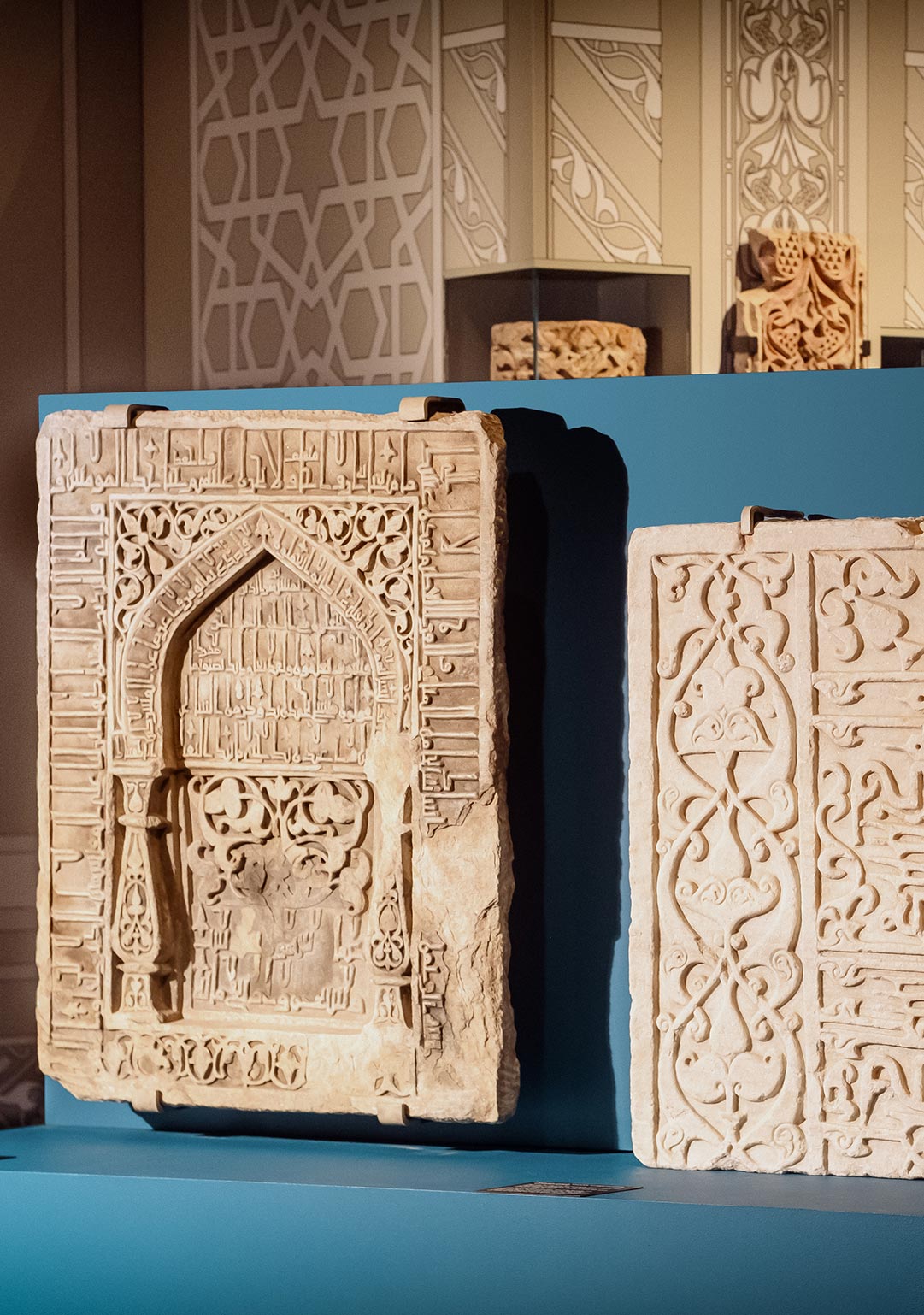
Far away or very close? The exhibition tells of the multi-layered connections between Stuttgart, Germany and Afghanistan. It displays historical objects, pre-Islamic and Islamic works of art as well as everyday yet significant objects.
It was developed by the Linden-Museum together with the Entangled: Stuttgart – Afghanistan working group. Since 2019, people from the Stuttgart region have been taking part, many of them with an international, Afghanistan-related history, as well as partners from academia and the arts. They have contributed to the exhibition in terms of concept, content and, in some cases, very personal memories and thoughts. Throughout the exhibition there are always references to the present – even with historical themes. This also happens through personal and critical comments or artistic positions.
The exhibition begins with transcontinental relations dating back thousands of years to the territory of present-day Afghanistan and an insight into the beginnings of German-Afghan history just over 100 years ago. Based on the collections of the Linden-Museum, it shows depictions of the Buddha and large-format marble panels from the Ghaznavid period (11th/12th century), in conjunction with new research and information on provenance. Visitors can experience them interactively using augmented reality.
One focus of the exhibition is the Stuttgart Badakhshan expedition of 1962/63, the Linden-Museum’s largest and longest research trip. It is being retold through research and the participation of many actors between Stuttgart and Afghanistan. The exhibition also reports on trips to Afghanistan and German families in Kabul in the 1970s. Another large area is about things and their various meanings – especially in the 20th and 21st century – textiles, jewelry, furniture and tableware. The exhibits are linked to stories of travel, and in some cases of migration, war and flight, and also raise political questions. His works deal with belonging, identity politics, conflict and migration, often with reference to Afghanistan.
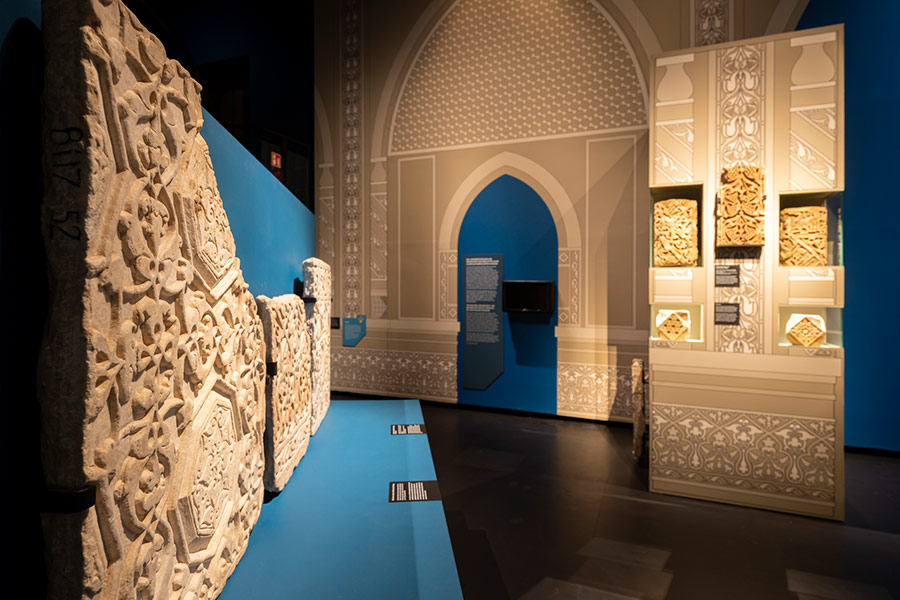
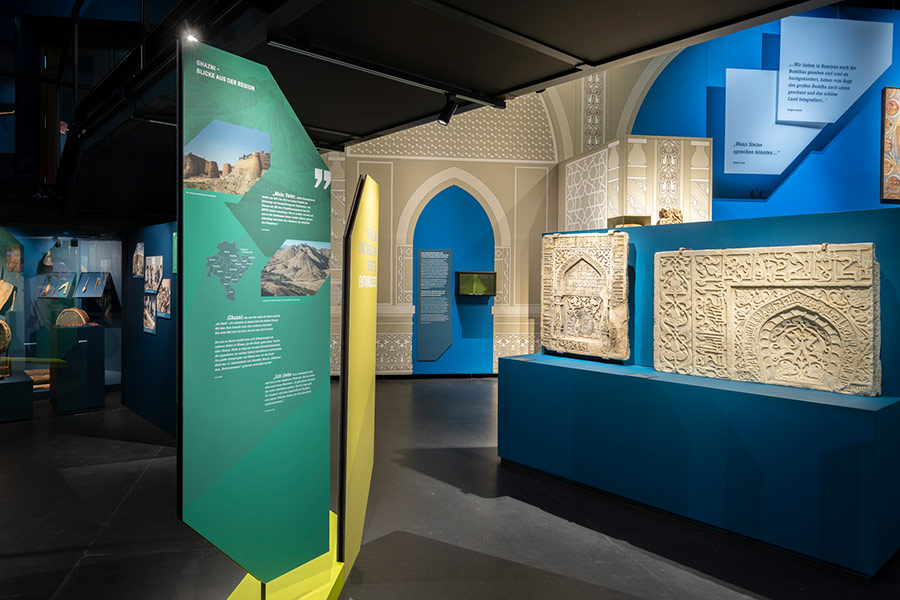
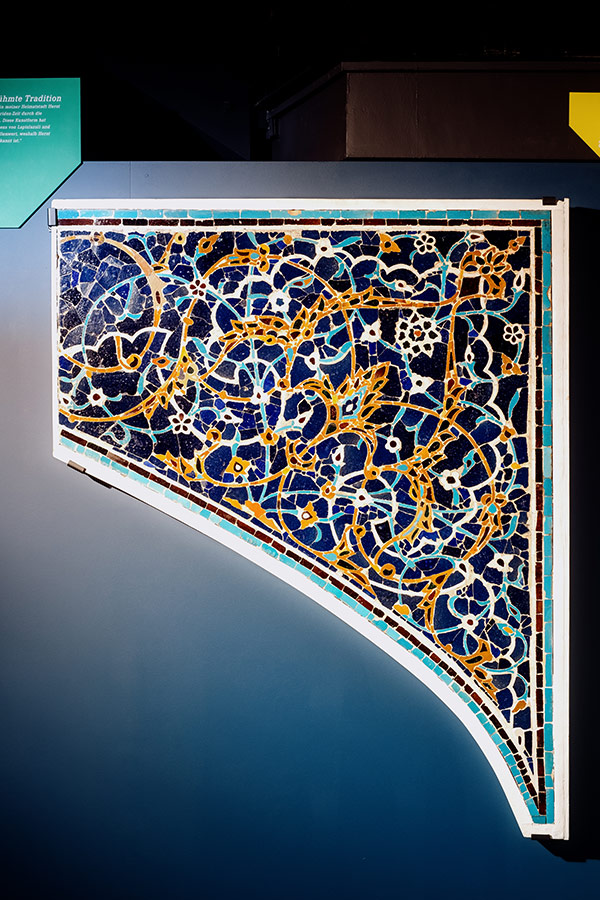
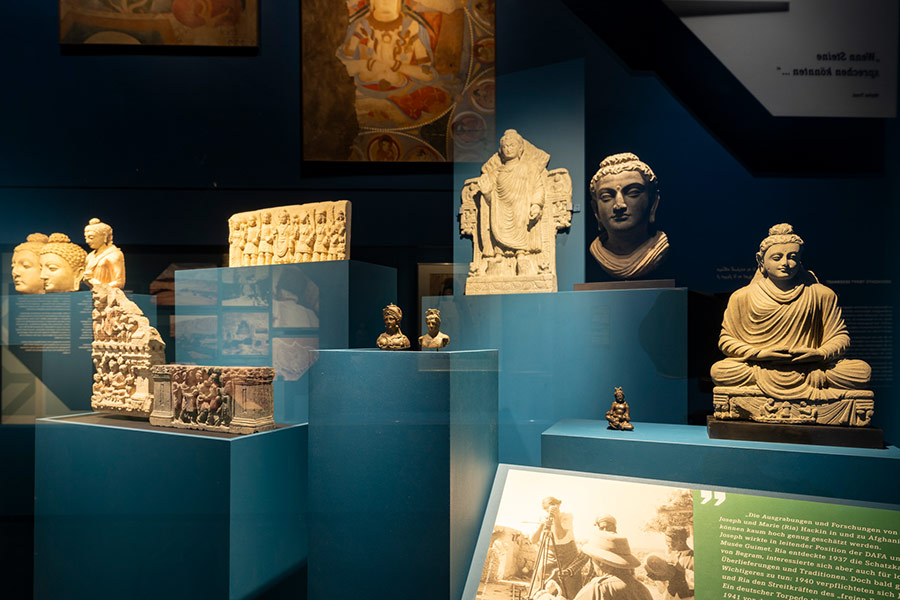

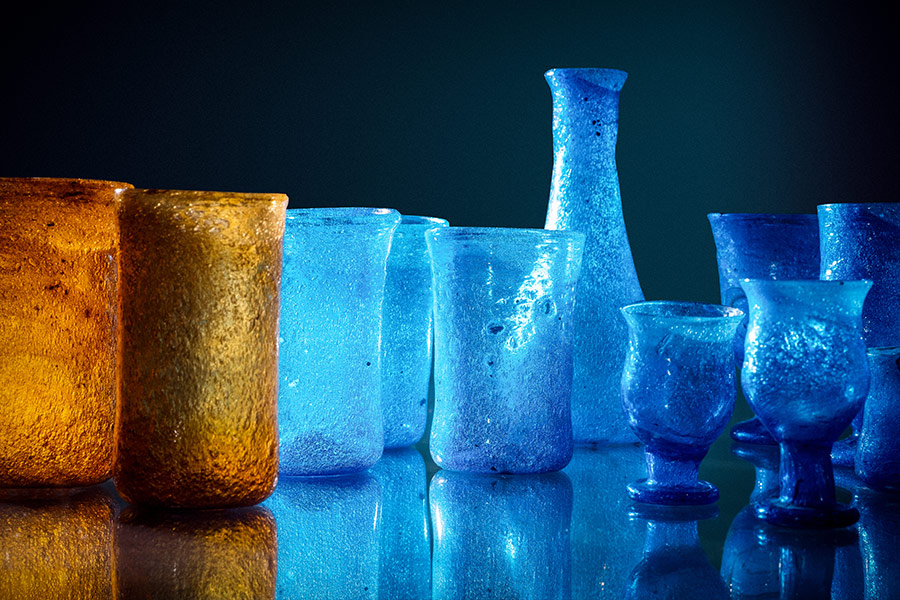
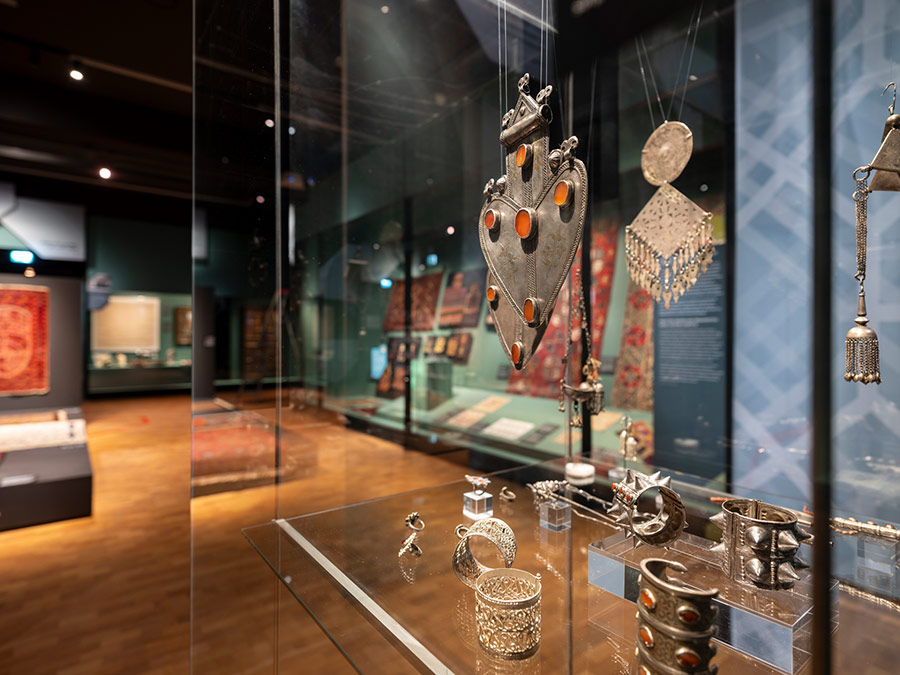
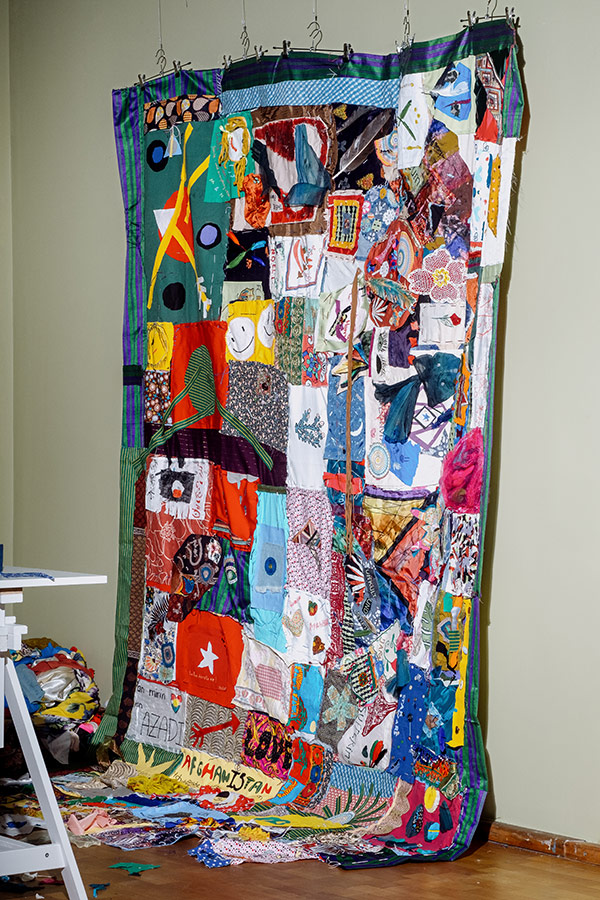
Selected works by Abdul Ghafur Brechna (1907 – 1974) accompany the themes presented. Brechna was one of Afghanistan’s most important artists. His multifaceted work as a painter, composer, poet and director influenced the development and renewal of art and culture in Afghanistan in the 20th century.
Books, stories, games, music: two special rooms, the “library” and the “tea room”, invite you to linger, reflect and participate. The exhibition is accompanied by an extensive program that highlights and deepens further connections between Stuttgart and Afghanistan.
The exhibition features numerous objects from the Linden Museum’s collection. They are supplemented by exhibits from German and European museums, in particular from collections that came to Europe on the basis of archaeological cooperation with Afghanistan.
In its complexity, the exhibition opens up new perspectives on the closely interwoven relationships between Stuttgart, Germany and Afghanistan.
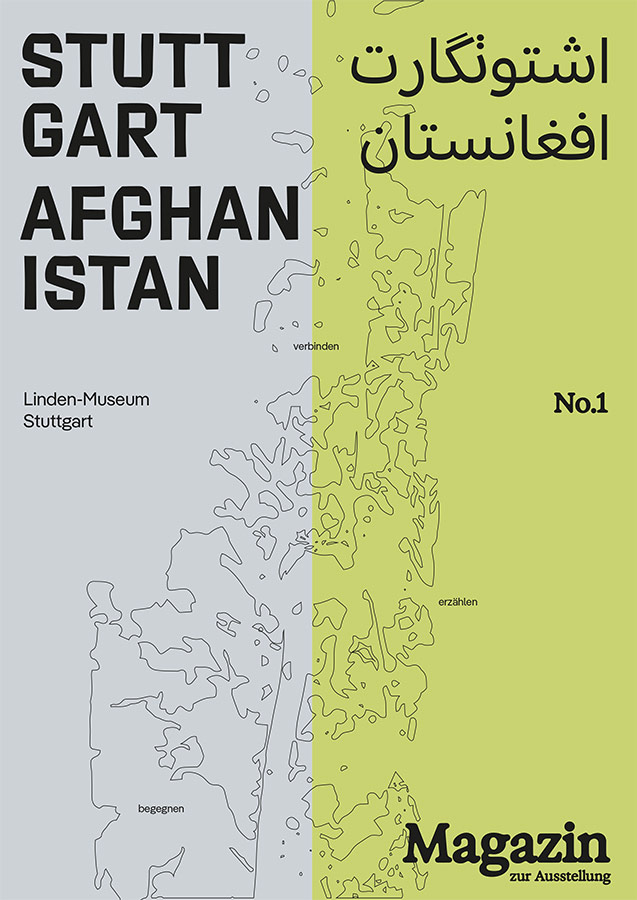
The magazine delves deeper into the questions and themes of the exhibition and offers surprising perspectives. Get your copy in our shop for € 9.

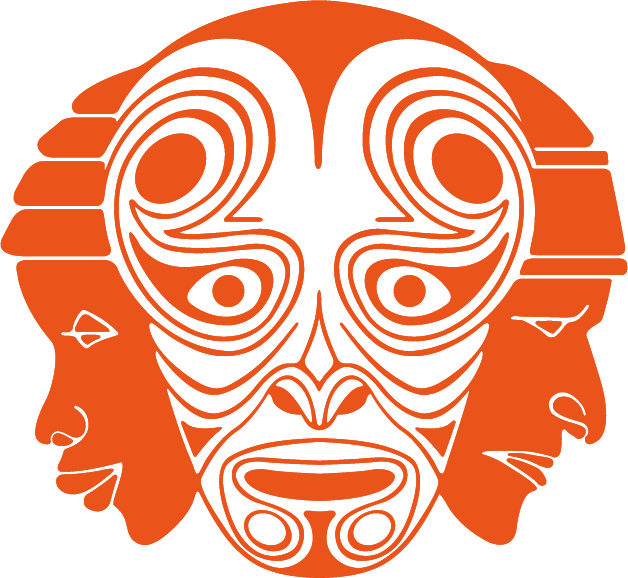
New forms of cooperation – with representatives of the Kayan/Kayaw (Myanmar)
Indigenous groups have often been repeatedly marginalized by precolonial empires, colonial powers, and postcolonial nation-states. Threatened by poverty and wars, they often sold their cultural goods. How can museums, as keepers of these collections, contribute to the strengthening of such societies today? Together with representatives of indigenous cultural initiatives from the Karenni region in eastern Myanmar, LindenLAB 1 experimented with new forms of cooperation and the sharing of know-how and resources.
Mutual visits, joint project development
A first part of the LAB took place on site in the Karenni region of Myanmar. Here, the project was developed by Dr. Georg Noack together with representatives of indigenous cultural initiatives. The first workshops were held. In the second part, our indigenous partners were guests at the Linden Museum for four weeks in November 2019. Here they had the opportunity to get to know our collections and to familiarize themselves with our approaches to exhibition design, conservation of valuable objects and cultural mediation. They took away many suggestions for their own cultural work, which we want to continue to support in an advisory capacity. The LAB-created exhibition, curated by Olivia Musu and Patricio Doei of the Kayaw Literature and Culture Central Committee and Khun Vincentio Besign and Khun Myo Aung of the Kayan Literature and Culture Central Committee, is part of the permanent exhibition South/Southeast Asia.
Whakawhānaungatanga – Connecting taonga Māori
Since the end of the 19th century, nearly 150 Taonga Māori (Treasures of the Māori) from Aotearoa New Zealand have entered the Linden Museum’s collection. Clothing, jewelry and weapons, tools, carvings and a carved house make up the bulk of these objects. Many things arrived in Stuttgart by different routes. They were gifts from European travelers, acquired for the museum by patrons, or taken from other collections by exchange or purchase. Little or nothing is known about their whakapapa (genealogy) – the names of their makers, their former owners, and their history in Aotearoa New Zealand. Nevertheless, the Taonga are important and full of meaning for the Māori today. LindenLAB 3 aims to highlight this and at the same time create new relationships between Māori and the Linden Museum.
Making connections between Māori and the museum visible
As part of LindenLAB 3, we explored new ways of engaging with Taonga Māori online and on site by tracing their origins and considering how this creates meaning, Mana and Kōrero, between Māori and the Linden Museum. The project, in collaboration with and guided by Māori researchers and experts, has revealed connections that link the Stuttgart collection to individuals and local communities, as well as to the histories of institutions and nations. We investigated concepts and forms of presentation that can make these relationships visible – without losing sight of the respective cultural meanings, aesthetics, and artistic expressiveness of the objects. In LindenLAB 3, contributors direct individual glances at selected assemblages of historical and contemporary Taonga Māori, underscoring the dynamism of a living collection.
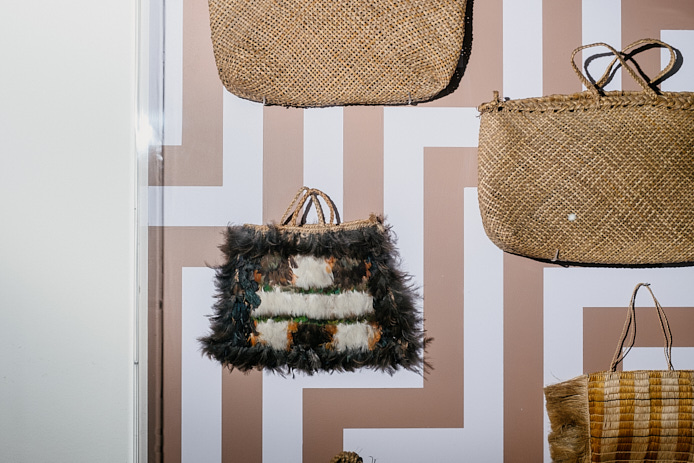
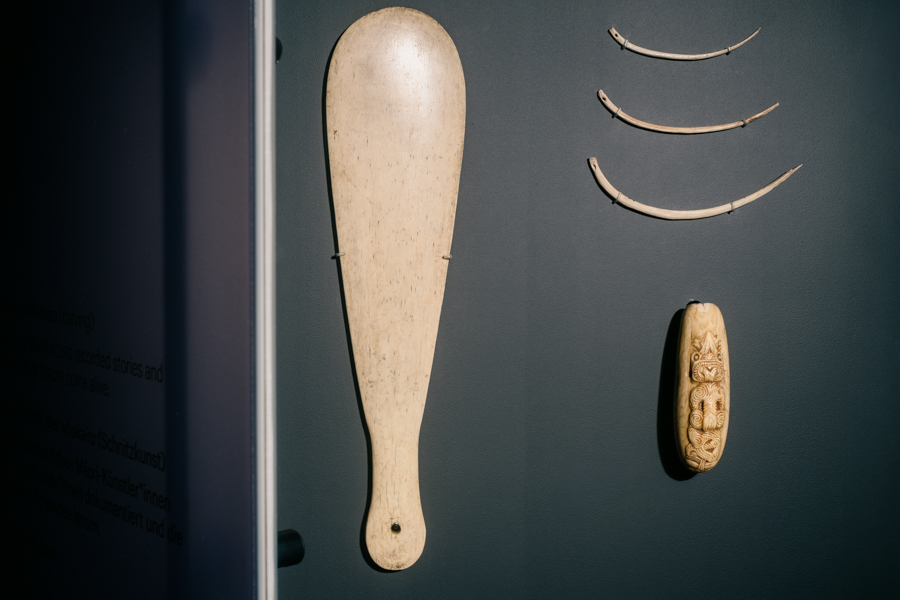
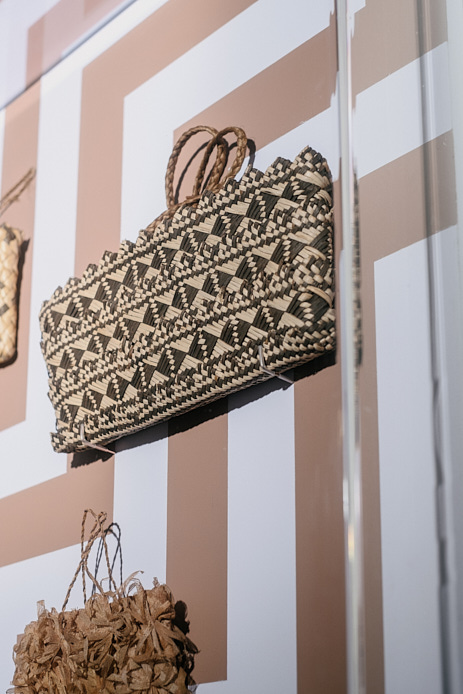
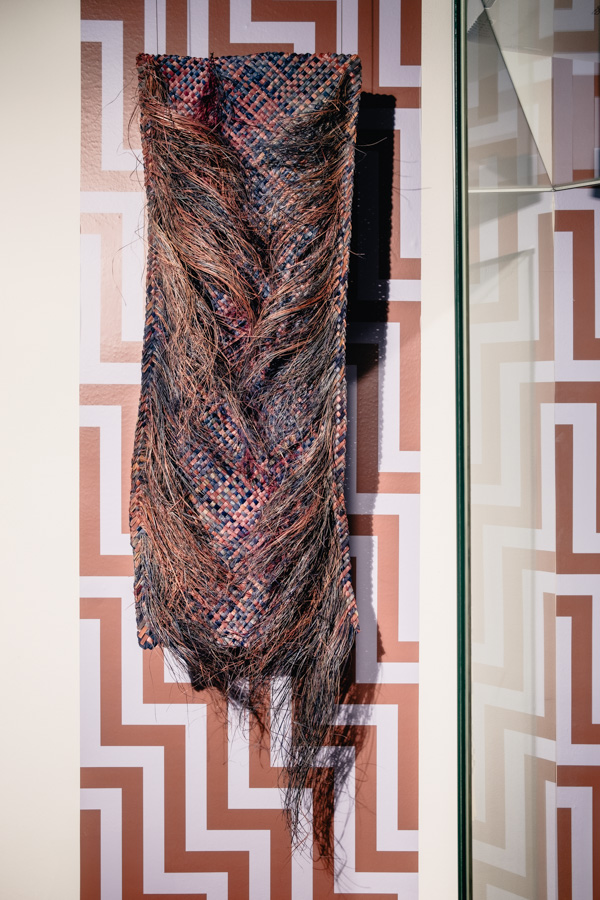
LAB partners
Ngarino Ellis (Ngāpuhi, Ngāti Porou) is Professor of Art History at the University of Auckland and author of the book A Whakapapa of Tradition: 100 years of Ngāti Porou carving, 1830 – 1930 (2016). She has managed and coordinated the LindenLAB 3 partners since the start of the project.
Dougal Austin (Kāti Māmoe, Kāi Tahu, Waitaha) is curator of Māori collections at the Te Papa Tongarewa Museum in Wellington and author of Te Hei Tiki: an enduring treasure in a cultural continuum (2019).
Awhina Tamarapa (Ngāti Kahungunu, Ngāti Ruanui) worked as a curator at Te Papa Museum and is an adjunct lecturer for the Museum and Heritage Studies Program at Victoria University Wellington, where she is also completing her PhD. She is the editor and author of Whatu Kākahu / Māori Cloaks (2011).
Justine Treadwell is a PhD student in Māori art history at the University of Auckland. Her research focuses on 18th century Māori textiles held in European collections. Previously, she assisted with the storage of the Māori textile collection at the Auckland Museum.
Laboratories are experimental fields of utopian thinking. In seven LindenLABs on the topics of provenance, participation and presentation, we have tried out a lot over the last four years. In conclusion, however, questions remain: What exactly did we test? What remains of this experiment? What will we discard? How can the project be transferred to museum work in the long term? And how do we meet a multifaceted social demand as an ethnological museum?
With LAB 8, we make findings from the LindenLAB visible once again in the museum. Experiences and ideas for the further development of the museum are outlined in five thematic areas at selected locations. The exhibition intervention can be seen at various locations in the permanent exhibition as well as in the foyer and checkroom area.
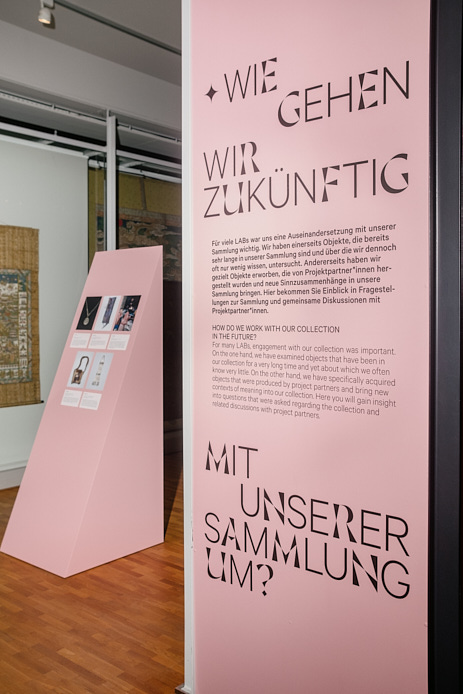
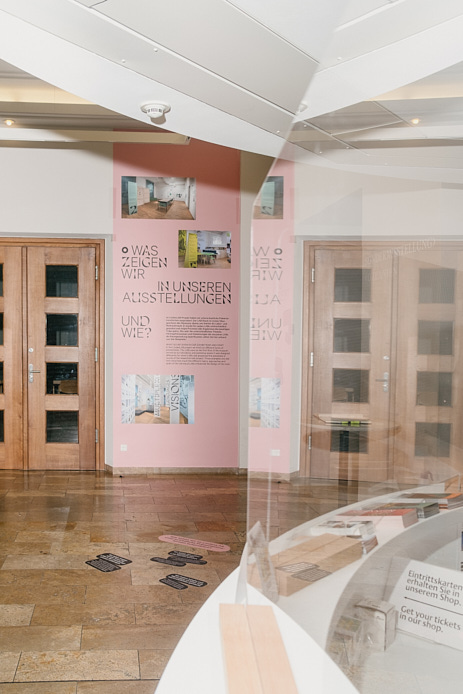
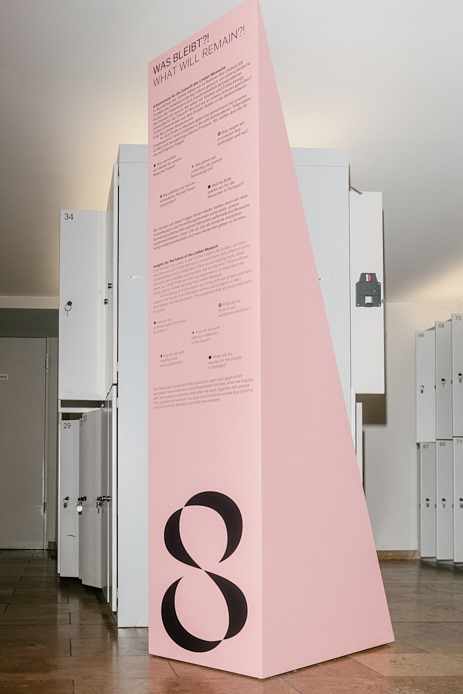
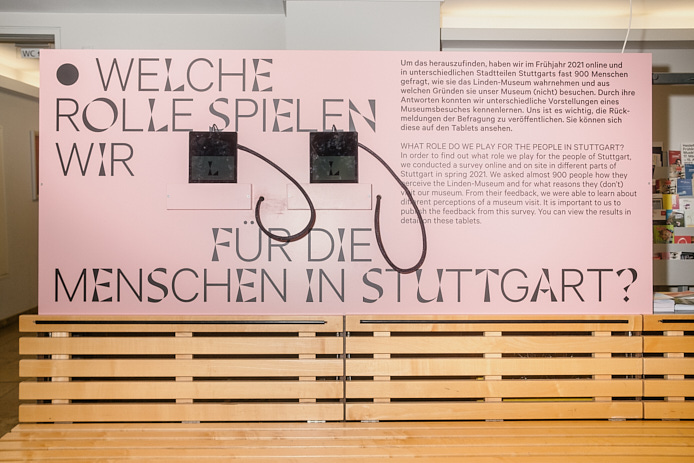
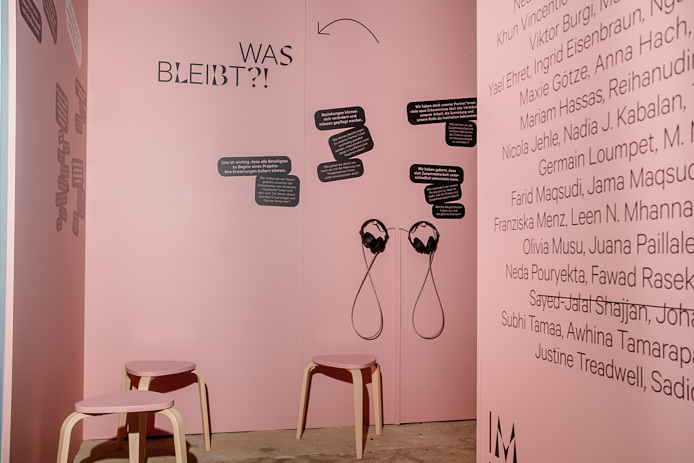
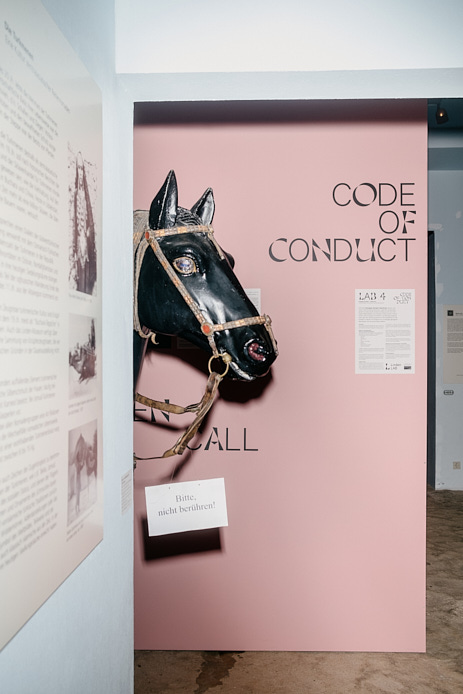


What is a “good life”?
At the center of LindenLAB 7 is the contemporary silver jewelry made by silversmiths Millaray Garrido and Mario Cayupi, with the accompanying costumes of two ritual assistants (ñangkan) of shamans (machi). Both the traditional costumes and the silver jewelry incorporate elements that relate to Mapuche cosmology and thus to buen vivir. The spiritual balance between man, nature, ancestors and spirits guarantees a good life, the buen vivir. The shamans and their ñangkan are responsible for maintaining or even restoring this balance through rituals.
A living culture
For the Mapuche artists, it was of great importance to be able to give a contemporary collection to a European museum that represents the vibrancy, beauty and diversity of Mapuche culture. The presentation is complemented by elements of the historical collection selected by Juana Paillalef.
Wallmapu, the Mapuche region
The Mapuche (people of the earth, from Mapundungún mapu = earth and che = people) live mostly in Chile, a good tenth in Argentina. Today, it is estimated that there are approximately two million people who identify as Mapuche. Most of them now live in the major Chilean cities of Santiago de Chile and Concepción. The core region of Mapuche territory, however, is Araucanía in southern Chile, with the city of Temuco as its commercial and political center. In 1883, the Mapuche were subjugated by the Chilean and Argentinean militaries and incorporated into their respective states. From the middle of the 19th century, many Europeans, especially Germans, immigrated to the Araucanía. To this day, the southern Chilean Lake District is strongly influenced by German immigration. Despite this long period of colonization, the Mapuche managed to preserve their culture and give it new validity through re-traditionalization.
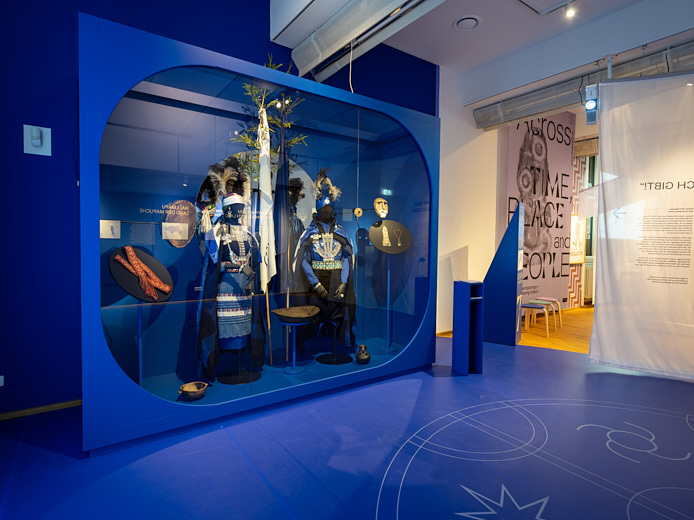
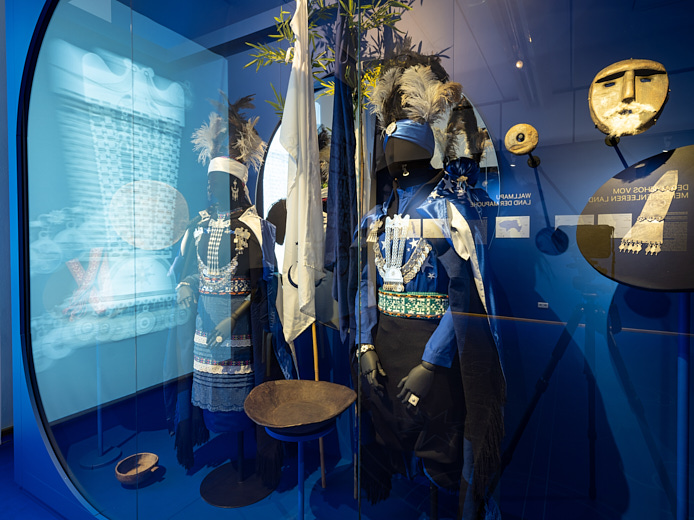
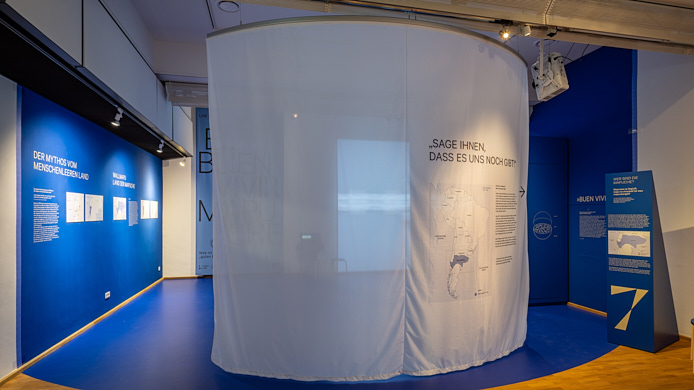
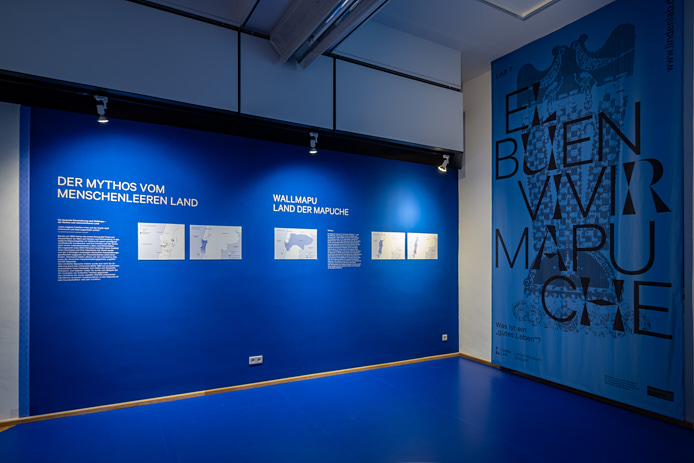
LAB partners
LindenLAB 7 was designed in collaboration with Juana Paillalef, who is Mapuche herself and was director of the Museo Mapuche in Cañete, Chile, until December 2021. She researched the collection of the Linden Museum in collaboration with other experts, such as the famous Mapuche silversmith José Antonio Painecura.


Asearch for a future of history
LindenLAB 6 showed – for the first time in the “recent” history of the Linden-Museum – a selection of the 238 objects sent by Hermann Karl Bertram to Karl Graf von Linden in 1908. Bertram was a first lieutenant of a so-called “Schutztruppe” in Cameroon and took part in the “Southern Expedition” between 1905 and 1907. This military action was aimed at subjugating the political institutions in south-eastern Cameroon, gaining control of the region and supporting the interests of the European trading companies operating in the region at the time.
LAB partners
The three project partners of LindenLAB 6 – Professor Germain Loumpet, Tah Kennette Konsum and Stone Karim Mohamad – have long been working in different ways to disseminate knowledge about the stories embedded in Cameroon’s cultural heritage. On their way together from the museum depot back to south-eastern Cameroon, they came into contact with a long-lost historical collection as well as with each other. In the presentation, they provided insights into a lively discussion about the politics of cultural memory in Germany and Cameroon.
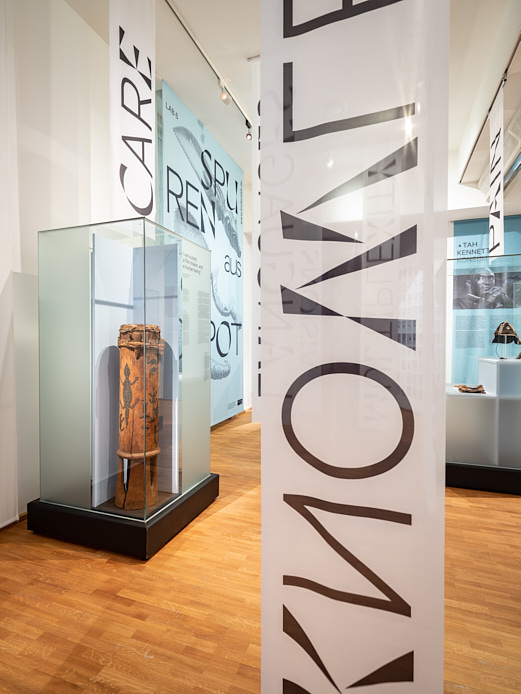
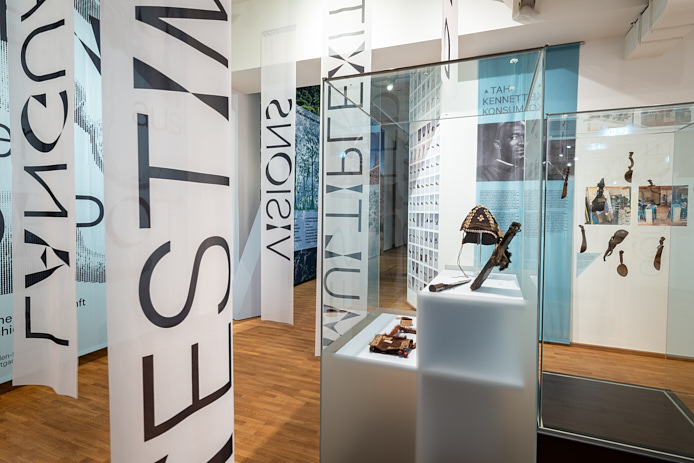

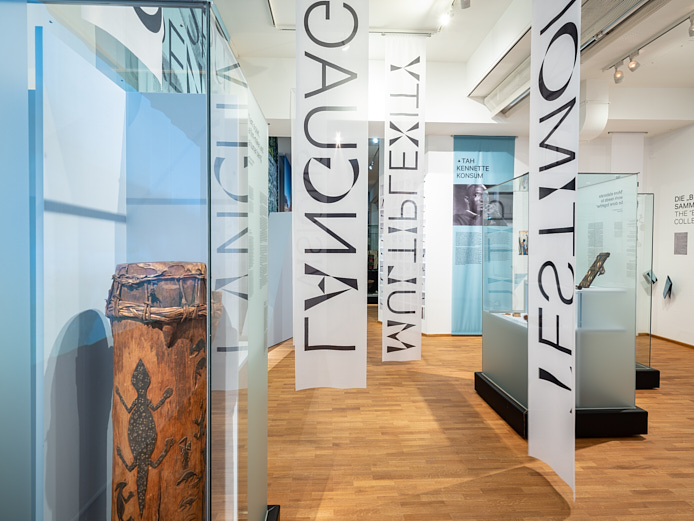
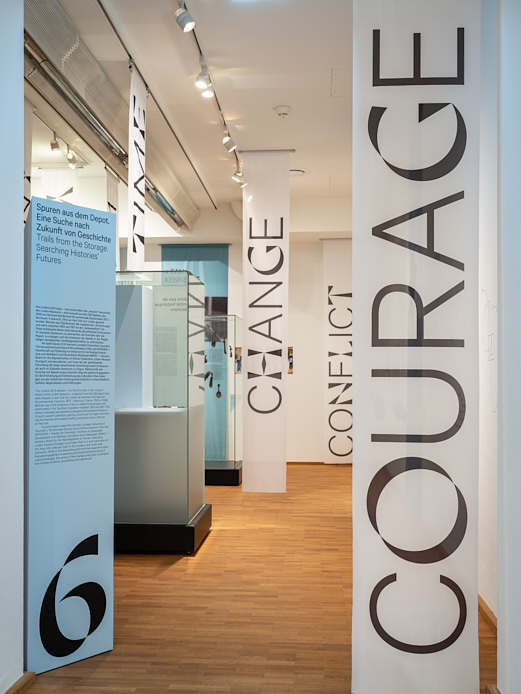



The large temporary exhibition of the state of Baden-Württemberg showed the history and present of Tamil culture. Over 80 million people in India, Sri Lanka and other parts of the world identify themselves as Tamils: They share the same language, Tamil, which originated in the south of India. “Of Love and War” sought to bring their history and stories to life in a variety of ways, with different people sharing their stories about Tamil cultures and identities. They spoke about social movements, performing and visual arts, aspects of everyday culture and religious diversity.
The exhibition showed archaeological objects attributed to the Caṅkam period, a selection of bronzes from the Cōḻa dynasty (9th-13th century), as well as works by artists of the Madras Art Movement from the second half of the 20th century. Social aspects of history were also highlighted with the caste-crossing Bhakti mysticism of the Middle Ages, the “Dravidian movement” of the 20th century and the struggle of the Liberation Tigers of Tamil Eelam for a separate Tamil state in Sri Lanka, which lasted until 2009.
Love and War, akam and puṟam
The Tamil language is a language of poetry. It has been spoken for over 3,000 years and conveys the culture and values of the Tamil people. Poets have always been highly esteemed and regarded as moral authorities. They joined together in so-called Caṅkams and created literature that is influental today and unites the speakers of Tamil beyond states, castes and religions. This early poetry in particular knew two main genres of artistic expression: akam and puṟam. Akam means the internal, the personal, that which is about love; puṟam, on the other hand, is the external, the public, that which is about war. These two sides were present throughout the exhibition – in the stories told as well as in the exhibits on display. Tiṇai also appeared time and again, using images from the landscapes of South India in poetry, art and pop culture to refer to “inner landscapes” and the emotions associated with them.
Religious diversity
The exhibition also made it possible to experience the great religious diversity that exists in southern India. In addition to elegant statues from the temples of the Cōḻa, a village shrine to the god Aiyanar and the construction of colorful Kolu figures, historically significant objects from the heyday of Buddhism and Jainism were also on display. Muslim and Christian culture were also present in the south of India at an early stage and had a weighty influence on Tamil culture and art. For example, the Sufi order, established by Muslim traders, was very popular because of its intensive exchange with Hindu spirituality. Shrines over the graves of famous Sufis, known as dargahs, developed into transreligious pilgrimage sites for Hindus, Muslims and Christians.
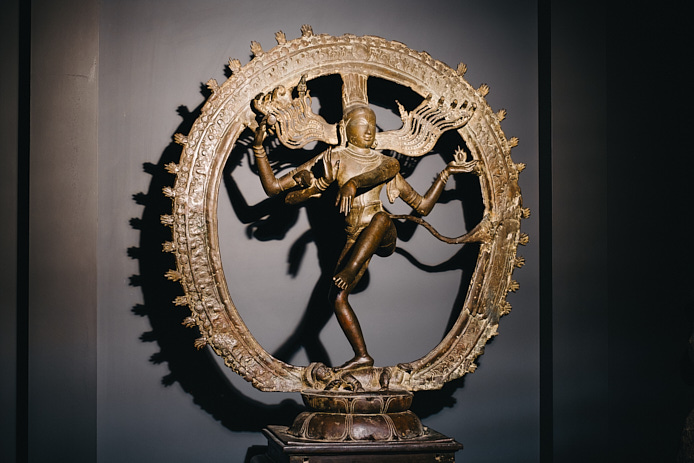
Worldwide collaborations
The exhibition was curated by Dr. Georg Noack (Linden-Museum Stuttgart) and Dr. M. D. Muthukumaraswamy (National Folklore Support Centre) from Chennai. In addition, we have invited partners from different parts of the world to contribute their perspectives on aspects of Tamil culture, art, history and religions. In various modules – poetry, social movements, art, popular culture, religion and everyday life – “Of Love and War” thus created a dense description from diverse positions and perspectives. We also owe many of the objects shown in the exhibition to worldwide collaborations. In addition to exhibits from our collection, we were able to present loans from the Museum Rietberg Zurich, the Musée National des Arts Asiatiques Guimet in Paris, the Museum for Asian Art Berlin, the Danish National Museum in Copenhagen and the Religious Studies Collection of the Philipps University of Marburg. The exhibition also included old inscriptions, manuscripts and prints from the Leiden University Library, the Rojah Mutthiah Research Library in Chennai, the archive of the Francke Foundations in Halle and the Württemberg State Library in Stuttgart.
Exhibition booklet for children: Ganapati – Bringer of luck and companion
Ganapati accompanied children through the exhibition with puzzles and tasks. Ganapati, who is also known as Gaṇeśa, is worshipped as a bringer of luck. With him, the children got to know important poets and religious figures, looked at works of art or wrote a few Tamil words.
The Linden-Museum houses thousands of objects, photos and documents from Afghanistan. Their exciting, sometimes problematic stories tell us a lot about personal experiences and memories, but also about political and economic backgrounds and interdependencies. They represent highly ambivalent facets of German-Afghan relations in the past and present. A working group of interested people from Stuttgart and the surrounding area, both with and without a connection to Afghanistan, focused primarily on the photographs of the Stuttgart Badakhshan Expedition (1962/63). The results of their work were exhibited in the museum’s LAB room on the 1st floor.
The LindenLAB was funded by the Initiative for Ethnological Collections of the German Federal Cultural Foundation.
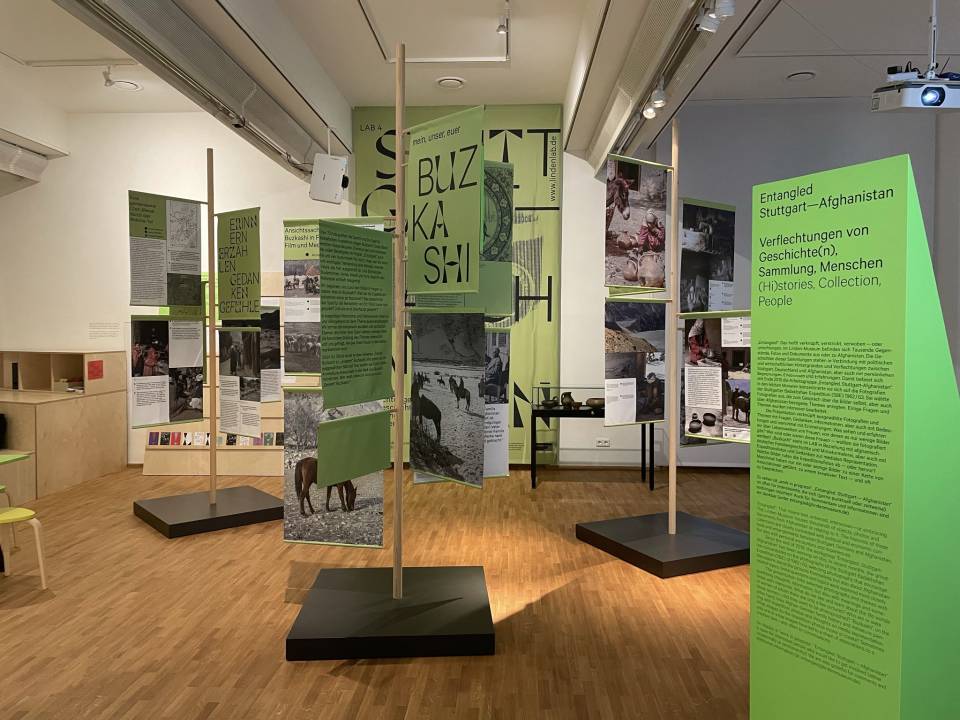

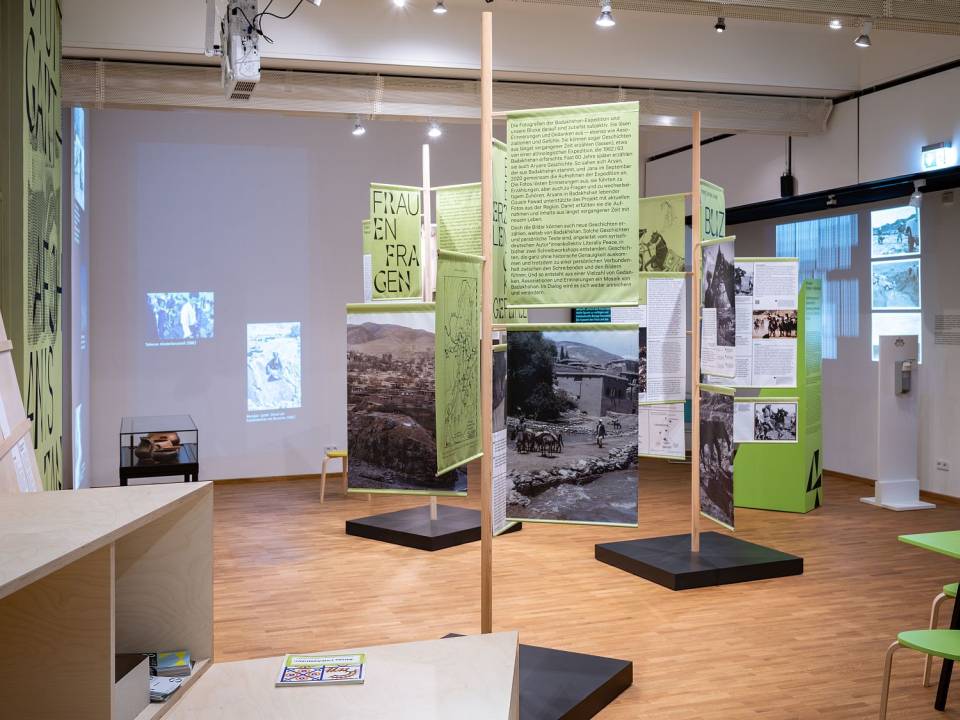
LAB 5 focused on the relationships between people, objects and the museum as an institution. How are these relationships formed and developed? What language and space do we need for this? The theme of language is central to a museum. In guided tours, exhibition and catalog texts, press releases and other media, we speak to and with the visitors. As a museum, we position ourselves through this: What does it mean to write in a non-discriminatory and gender-appropriate way? How can we use easy language to make texts more understandable? How can we change our everyday spoken language? What structures need to be broken down to achieve this? Which images do we use and which do we not?
The LindenLAB was funded as part of the Initiative for Ethnological Collections of the German Federal Cultural Foundation.



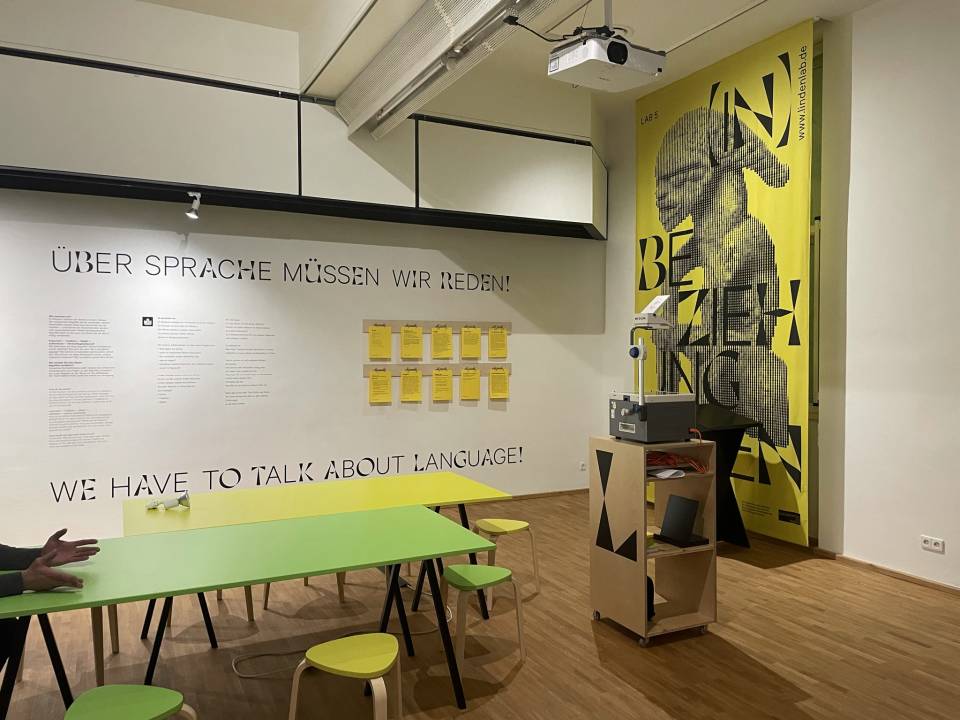
Around the museum with Tri!
As part of LAB 5, the research book “Ich sehe was, was du nicht siehst” (I see something you don’t see) was created for children: The Triangle Tri invites children and their friends, parents or grandparents to explore the permanent exhibitions with all their senses independently and in a playful way with experimental research assignments. Research assignments are available free of charge in the lobby and at the museum box office.
LindenLAB Podcast
In cooperation with Stuttgart Media University, the first season of the LindenLAB podcast was created, which picks up on LAB 5 topics and brings them “into conversation“.
What does language have to do with social structures? Does critical language about racism change consciousness? Or is that just cosmetics?
Zacharias Hauswirth and Faisal Osman are active in the Black Community Foundation Stuttgart. In the first episode of the LindenLAB podcast, they talk with Johanna Speckert and Jana Trenner about basic things: the basic law, white museums and crayons.
Concept and production: Jenny Halda, Yasmin Ismaiel, Johanna Speckert, Jana Trenner, Sarah Zimmermann (HdM Stuttgart) and Martin Otto-Hörbrand (Linden-Museum Stuttgart), online from 13.4.2021, recorded on 26.1.2021
Also in the second episode of the LindenLAB podcast, Zacharias Hauswirth and Faisal Osman are guests. Both are active in the Black Community Foundation Stuttgart. In this episode, they talk to Nareh Khoorshidian and Estelle Rekasowski about dealing with everyday racism and the question of what each individual can do to sensitize themselves to it.
Concept and production: Ievgeniia Brauer, Nareh Khoorshidian, Achara Kunz, Estelle Rekasowski (HdM Stuttgart), Henrike Louise Hoffmann (Linden-Museum Stuttgart), recorded February 2021
Tracy Osei-Tutu from the Democratic Voice of Youth Association and Harald Völkl from the Linden-Museum Stuttgart talk to Ansgar Wörner about what it means to be authentic, how important it is in our time, and what museums have to do with it.
Concept and production: Daniel Baltes, Max Galys, Sina Hammerschmidt, René Kahremann, Lea Schubert, Ansgar Wörner (HdM Stuttgart), Harald Völkl (Linden-Museum Stuttgart), recorded January 27, 2021
With regard to a new museum, we discuss the topic of space: What spaces are needed in a museum and what do museums trigger in us? As a museum, the wishes and expectations of the visitors are important to us. In this episode, there is therefore a role reversal: Janette Helm, a research assistant at the Linden-Museum in Stuttgart, asks three students at the Stuttgart Media University about spaces in which they feel comfortable, which enable encounters or have created a special museum experience.
Concept and production: Stefan Breuning, Lena Glas, Chris Günthner, Lisa Schubert, Sandro Stiehle (HdM Stuttgart), Janette Helm (Linden-Museum Stuttgart), recorded February 2021
In times of political change, Helena Cing Deih Sian explored the current significance of the architectural heritage in Yangon/Myanmar. She examined the relationship between the spatial environment and political development.
In the cabinet exhibition, contemporary witnesses talked about 14 places in Yangon. These places have been left out of the ideological narratives of the military dictatorship and their significance for the future development of building culture and urban planning has not been taken into account. The stories about these places that have not yet been told are counter-narratives of the civilian efforts for democracy and freedom. These places stand out as “unofficial heritage sites” and underline the urgency for the question of who is entitled to dispose of them. Do they have to be specialists or can people without expertise have their say? What can remain and what will be demolished?
The exhibition offered an insight into the discourse surrounding the contested architectural heritage. With the aim of establishing a culture of remembrance for Yangon, Helena Cing Deih Sian invited visitors to participate and contribute their thoughts. After its stop in the South/Southeast Asia section of the Linden-Museum, the traveling exhibition was shown in cities with a large Myanmar diaspora: Frankfurt, Berlin and Hamburg.


Helena Cing Deih Sian, born in 1994 in Kalay/Myanmar, studied architecture and urban planning at the University of Stuttgart until April 2022. The exhibition was the subject of her final thesis.
In cooperation with:
University of Stuttgart, Urban Planning Institute International Urbanism
In the exhibition, 26 Tübingen students from China talked about arriving in a foreign country, studying at the University of Tübingen, cooking spaghetti in the dormitory kitchen, the expectations they brought with them, new friendships and dreams for the future. Tübingen was representative of all German universities: Students from China have long been the largest foreign student group at these universities. But how do the students from China experience their everyday life in Tübingen? What is their experience at the university? What problems do they encounter? What is new and important for them? How can togetherness be created on campus? And above all: What do they ultimately take back home with them from their stay in Germany – from their own “Chapter Germany”?
In order to be able to answer this question, they were accompanied in their everyday lives by twelve master’s students from the Ludwig Uhland Institute for Empirical Cultural Studies in Tübingen in a three-semester study project. During interviews, numerous joint cooking evenings and excursions, friendships and partners in joint research for the study project group were formed. The experiences of the Chinese students were the theme of the exhibition and they also had their say in the exhibition.
The “Chapter Germany” exhibition was created in close cooperation with the China Centrum Tübingen and the students and teachers of the International Master of Interior Architectural Design course at HFT Stuttgart. It was shown at the Linden-Museum Stuttgart as a cabinet exhibition in the East Asia department.
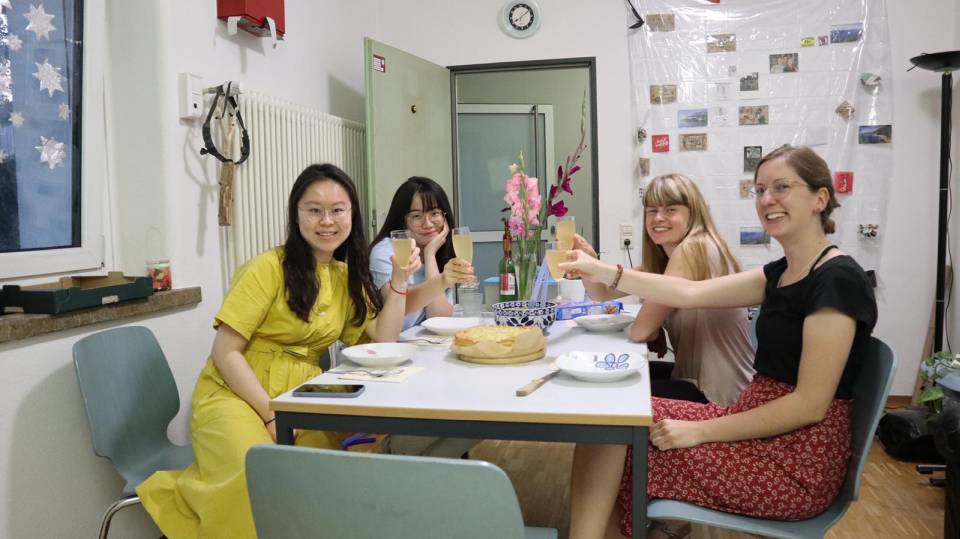
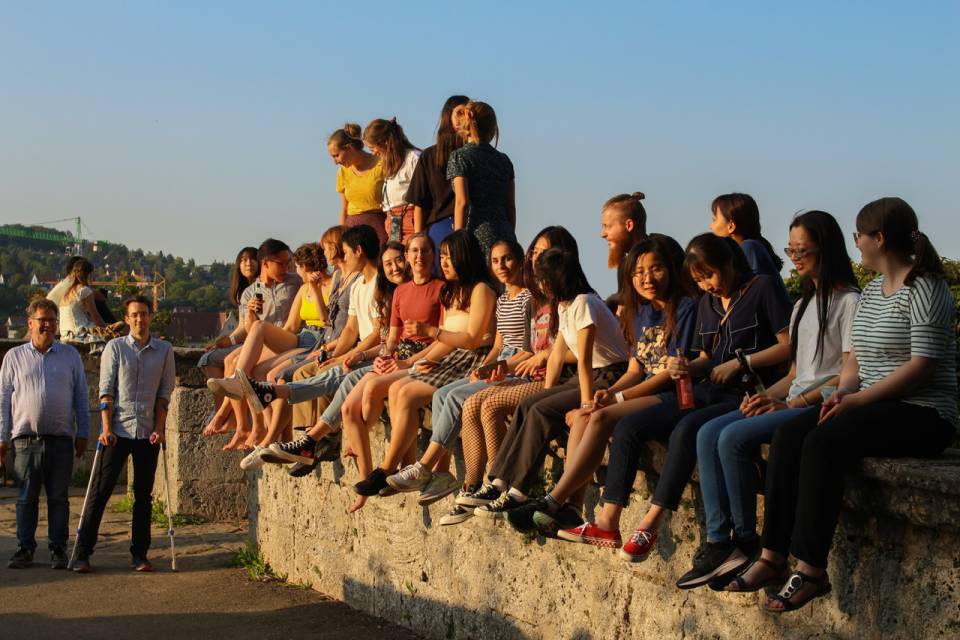
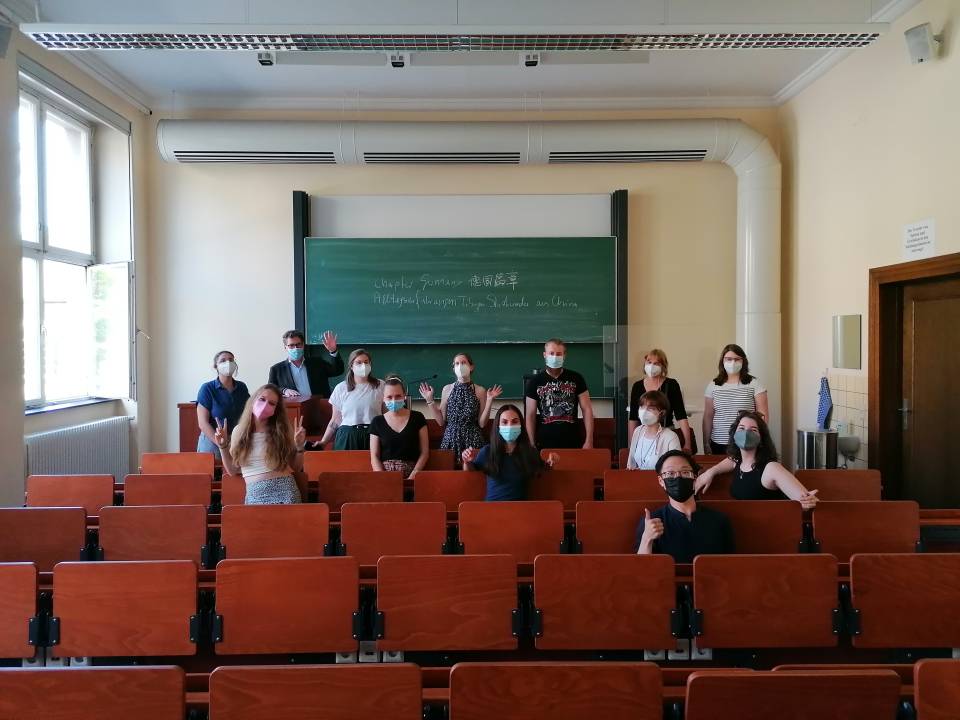

In cooperation with:
Eberhard Karls University Tübingen, China Center Tübingen, HFT Stuttgart
With the kind support of:
Federal Ministry of Education and Research, Karl Schlecht Stiftung, Tübinger Vereinigung für Volkskunde e.V., Universitätsbund Tübingen e. V., Stiftung Landesbank Baden-Württemberg, Netzwerk transformierender Lehre in Baden-Württemberg, Verein Freunde Hochschule für Technik Stuttgart
Podcast episode: China Ticker
What does the Linden Museum have to do with German colonialism? Which Württemberg actors were involved in colonialism? How present was colonialism in the everyday world of Württemberg? And how does it continue to have an effect today? The workshop exhibition showed the museum’s colonial connections between 1882, the year in which the Württembergischer Verein für Handelsgeographie was founded as the museum’s sponsor, and around 1940, and included effects up to the present day.
An important role was played by Karl Graf von Linden. He was chairman of the sponsoring association and left his mark on the museum during the colonial period. Accordingly, the museum was named after him in 1911. In addition, other personalities were presented who are part of stories that took place between the museum, Württemberg and the colonies. We also asked about those about whom we know little due to the colonial circumstances, but who were nevertheless instrumental in building up the collections. In a further step, the colonialist association system, which also includes the sponsoring association, was examined. Associations shaped social life and served as multipliers of colonial ideologies. Events such as colonial conferences, exhibitions and so-called “Völkerschauen” or objects of everyday culture show how deeply rooted colonialism was also in Stuttgart. The question was asked what continuities remain to this day.
Another thematic focus dealt with violence and focused on the so-called “Boxer War” in China (1900/01) as an example. Hundreds of Württemberg soldiers volunteered for this war, from which the Linden-Museum owns looted objects. Württembergers who took part in colonial expeditions and wars were honored with commemorative plaques and monuments, some of which still exist today. How should this be handled?
Provenance research at the museum was incorporated into the exhibition. In addition, the Linden-Museum specially commissioned a study on Württemberg and colonialism. Viewing the country’s history in the context of colonialism and highlighting the many cross-connections between institutions, people, and events is a new approach. Although some issues have been worked on before, scientific research and debate is just beginning on many issues. Critical distance and multi-perspectivity are central in order to avoid a one-sided or even nostalgic retelling of colonial history from the perspective of Württemberg actors. The fact that the debate was very much in motion was also evident in the exhibition. Based on the idea of the workshop, visitors were asked to answer questions, record their own thoughts or criticism and contribute or question their knowledge. The visitors were able to adopt different viewpoints and perspectives, gaps and connecting lines were revealed and the content was put up for discussion.


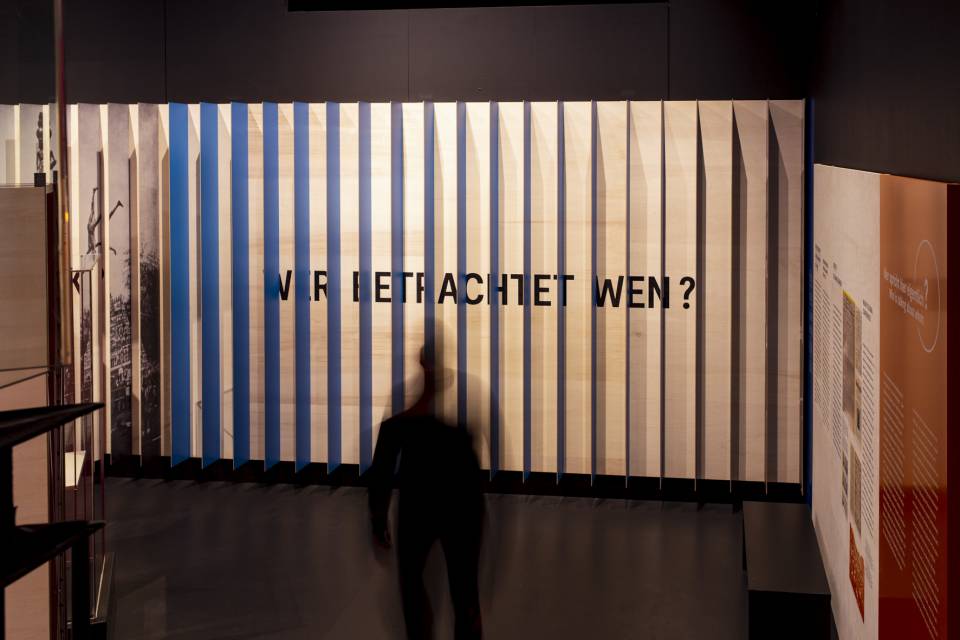
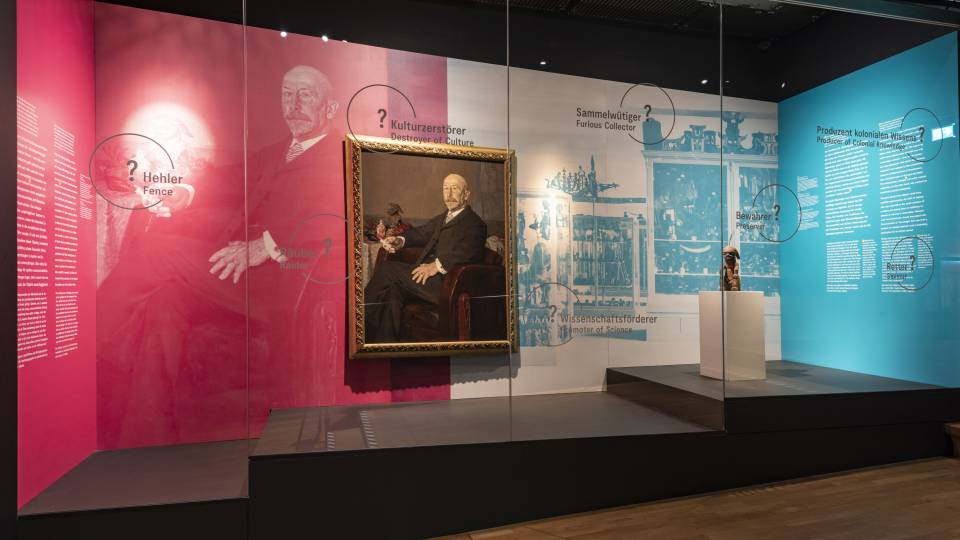


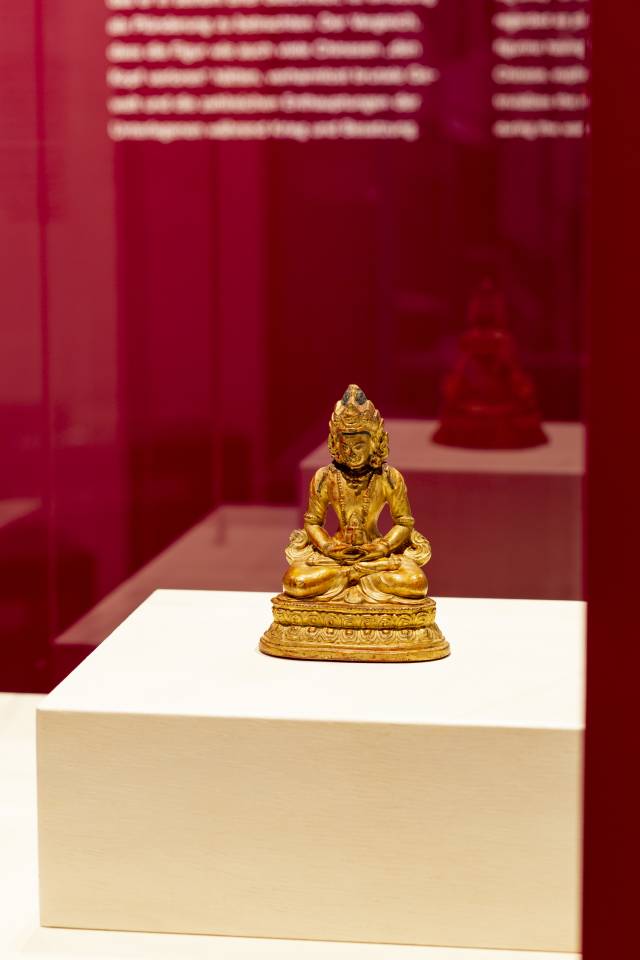
In the context of the exhibition, experts and activists with a connection to Stuttgart, the Linden-Museum and expertise around the topics of colonialism, postcolonialism, decolonization and antiracism have come together in an accompanying group to discuss the special exhibition “Difficult Heritage”.
Part of this discussion was presented in the workshop area of the exhibition and was intended to invite all visitors to reflect on the continuities of colonialism, the resulting patterns of behavior and privileges, and the possibilities for healing this open wound. The accompanying group hoped that the ideas, interventions and criticisms raised would find their way into the transformation process of the Linden-Museum and the reappraisal of the colonial heritage and be further developed and realized in the long term.
Audio guide “Critical change of perspective“
The legacy of the museum from a Black German perspective: Linda Addae’s audio guide drew attention to how colonialism and its continuities still have a significant influence on the realities of life for BIPoC (Black Indigenous People of Color). The perception of BIPoC evokes other interpretations of the exhibition’s theme, pointing to the contemporary implications of a supposedly closed history. The recordings were thought-provoking walks that took an interpretative look at stations in the exhibition and described certain aspects from an affective, affected perspective.
With the kind support of the Sparkassen-Finanzgruppe
Podcast episode: China Ticker – Curator Markus Himmelsbach on the so-called “Boxer War“
In public collections, archives and museums, political perspectives are (re)constructed and shaped in order to provide structures and content for the communication of history. In the process, a Eurocentric canon of knowledge was created over generations, which was critically and artistically questioned by students of the ABK Stuttgart in an exhibition. During the summer and winter semesters of 2021/22, students engaged in artistic research processes with selected (virtual) collections and the spaces of the Linden Museum in connection with the LindenLAB. In this exhibition, they presented their artistic works as new approaches and perspectives for communicating history and the present in a museum context.
RE-EXPLORE / RE-WRITE II was a seminar and an exhibition of the Intermedia Design Department, Stuttgart State Academy of Art and Design, under the direction of Professor Antonia Low and the artist Luise Schröder, in close collaboration with Henrike Hoffmann, project coordinator of the LindenLAB at the Linden-Museum.


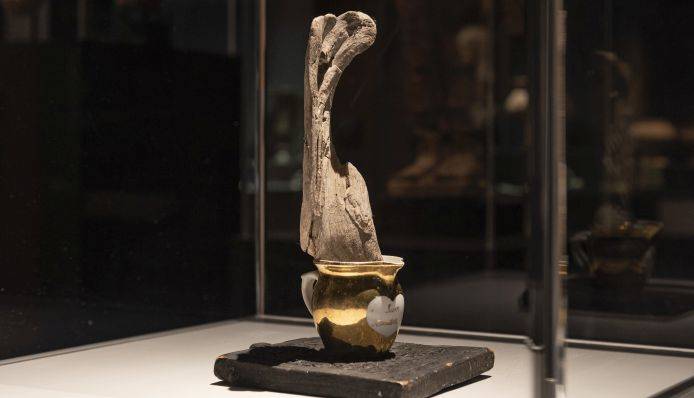
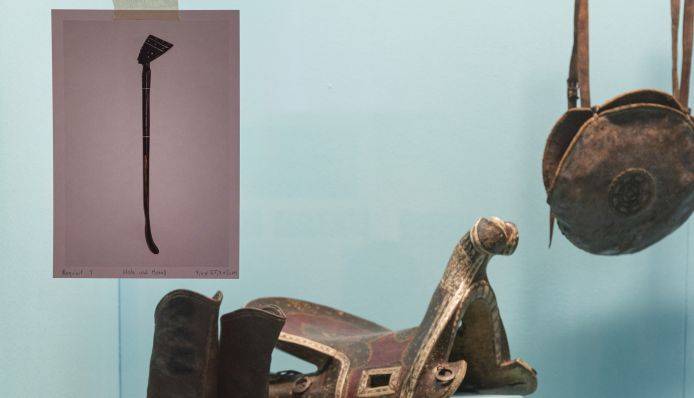




Participating artists:
Eunyoung Bae, Marie David, Vesna Hetzel, Janosch Müller, Sophie Rebentisch, Julia Schmutz, Veronika Schneider, Julia Helene Scholl
A cooperation of:
Stuttgart State Academy of Art and Design, LindenLAB
With the kind support of Stiftung Landesbank Baden-Württemberg and Kulturstiftung des Bundes
How do you trace the origin of objects? How did they get into the museum? Who gave them to the museum? In what context were they collected? Were they bought, given, traded, or possibly stolen? What consequences does this have for museums and scientists working with the objects today? These are the typical questions that provenance research deals with. LindenLAB 2 “Objects and Collectors” also addressed the question of how to communicate the results and working methods of provenance researchers.
The installation in LindenLAB 2 invited visitors to playfully experience the working methods of provenance researchers based on a real research assignment. Visitors were given an insight into the working methods and sources used and were able to discover the history behind them for themselves.
For LindenLAB 2, the collection of Karl Holz (1857 – 1934) was intensively considered. Holz was a merchant who probably emigrated to Chile in the early 1880s, henceforth calling himself Carlos Holz and supplying Karl Graf von Linden with many objects, especially Mapuche. What is the story behind his collection? What obstacles, twists and historical incidents are involved?
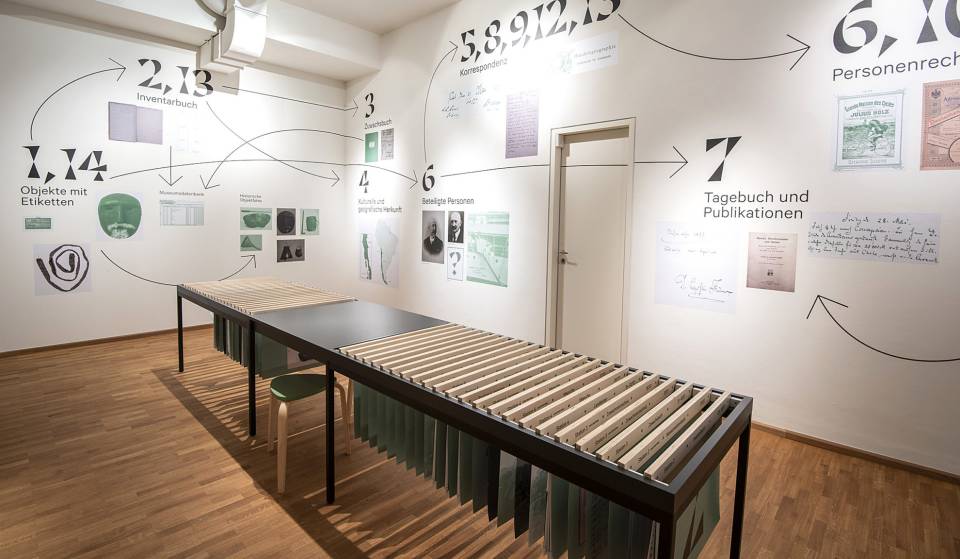

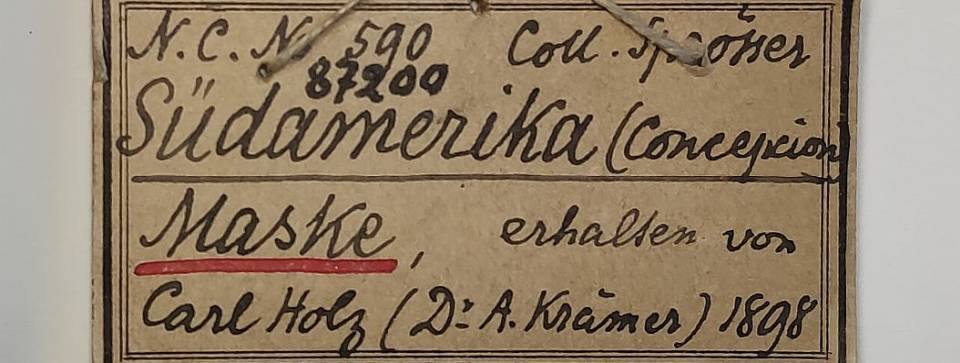
Public collections, archives and museums in particular have (re)constructed and shaped political perspectives in order to provide structures and content for the communication of history and culture. In the process, a Eurocentric canon of knowledge has developed over generations that needs to be critically and artistically questioned. The starting point for the artistic-scientific research was the (virtual) rooms and collections of the Linden-Museum. In the entrance area as well as in the rooms of the LindenLAB and the permanent exhibition, the first questions of critical investigation and reflection on collection practices and classification systems in the museum were presented.
On display were works by Marie David, Veronika Schneider, Julia Schmutz and Leonie Weber. An exhibition with final works was realized in 2022.
re-explore / re-write was led by Prof. Antonia Low and the artist Luise Schröder and took place in close cooperation with the Linden-Museum Stuttgart and the LindenLAB under Henrike Hoffmann.
A cooperation of:
Stuttgart State Academy of Art and Design, LindenLAB
With the kind support of: Kulturstiftung des Bundes
The Baden-Württemberg State Exhibtion, on the occasion of the 500th anniversary of the landing of the Spanish conquistador Hernán Cortés in the Gulf of Mexico opened up a new, in-depth look at the culture of the Aztecs. Beginning with the periphery of the Aztec empire (ca. 1430 – 1521) and the natural and cultural diversity of Mexico, the exhibition approached the interior of the empire and its capital Tenochtitlan. This part of the exhibition focused on two of the world’s four surviving Aztec feather shields and a high-quality greenstone figurine.
After passing through the ruling palace of Emperor Moctezuma, the visitors entered the very heart of the empire: the sacred precinct with the main temple Templo Mayor. The tributes that the Aztec empire imposed on its conquered provinces served as a guideline for the exhibition. They flowed to Tenochtitlan and in large numbers on to the Templo Mayor, as offerings to the gods.
An accomplished art
The Aztec stone sculptures captivate with their naturalistic and detailed representation, often combined with calendar signs, characteristics of certain deities or the combination of different gods. Valuable mosaic masks, feather work and gold jewelry give an idea of the splendor the conquistadors found at the court of the Aztec ruler. A separate thematic section was dedicated to the colorful illuminated manuscripts. A special feature of the exhibition was the presentation of the latest research and excavation results. The Templo Mayor excavation project and the associated museum provided us with recently discovered offerings that had never been exhibited before.
Top-class lenders
The exhibition presented around 150 high-caliber loans from Mexican and European museums. Lending institutions were the Museo Templo Mayor and the Museo Nacional de Antropología in Mexico City, the Musées royaux d’Art et d’Histoire (Brussels), the National Museum of Denmark (Copenhagen), the Tropenmuseum (Amsterdam), the Museum Volkenkunde (Leiden), the Museum der Kulturen Basel, the Weltmuseum Wien, the Museum am Rothenbaum (Hamburg), the Museum Weltkulturen (Mannheim), the Rautenstrauch-Joest-Museum (Cologne) and Schloss Friedenstein (Gotha).
Particularly noteworthy are the two feather shields and the greenstone figure from the Württemberg State Museum, which were on display for the first time in the context of Aztec culture.
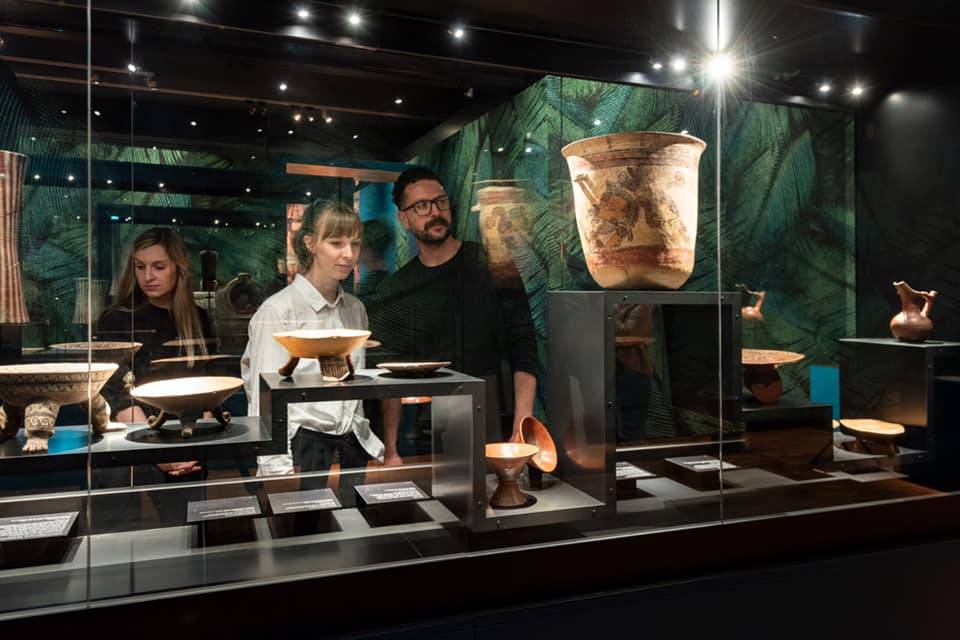
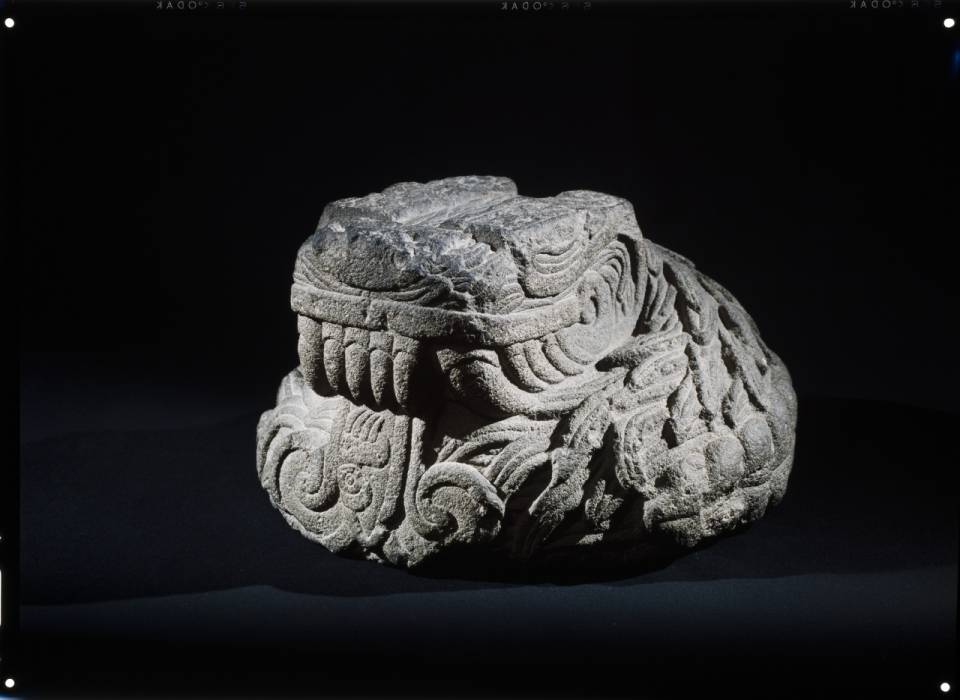

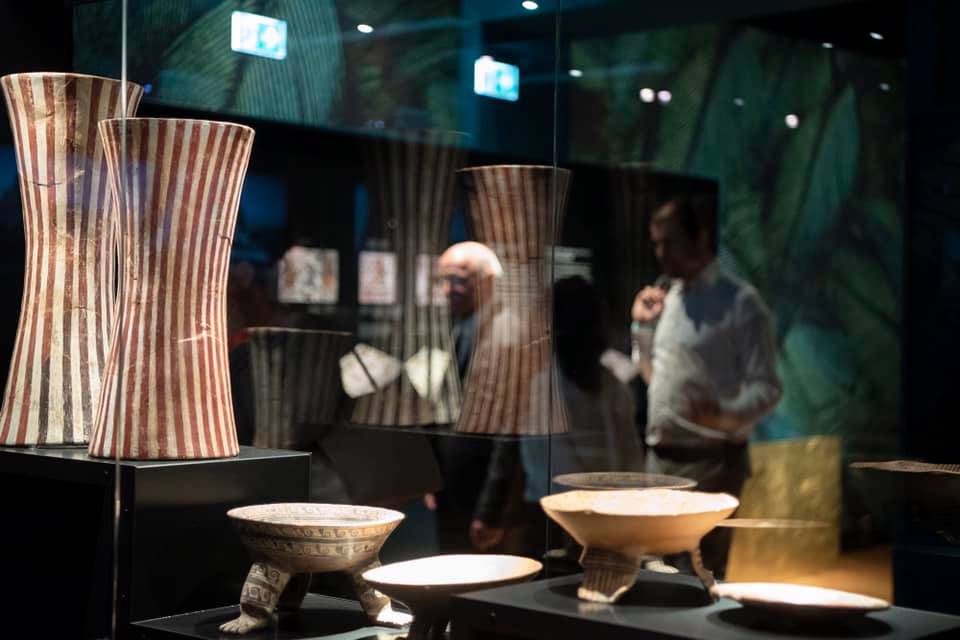
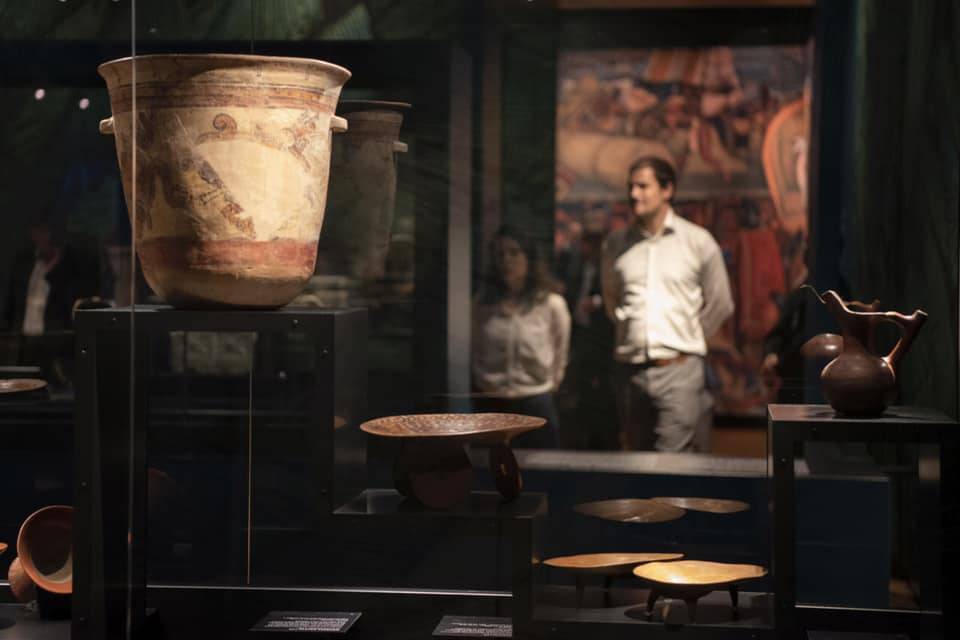
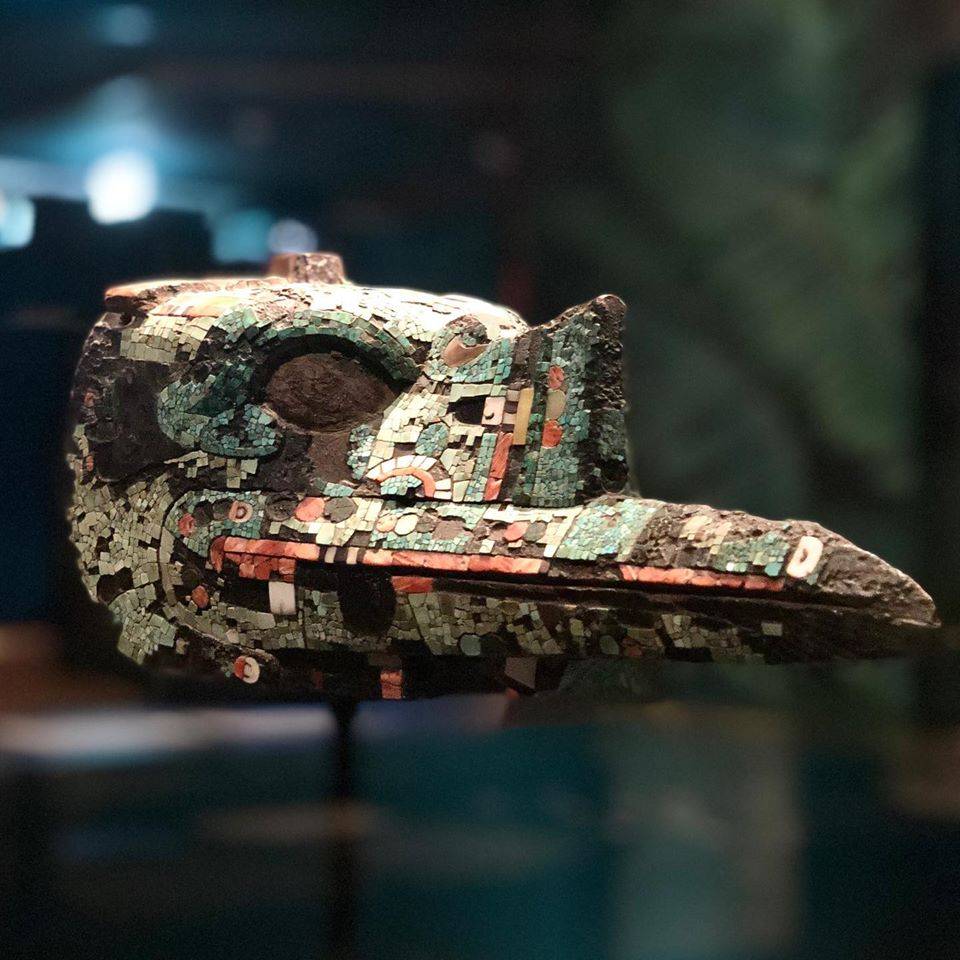
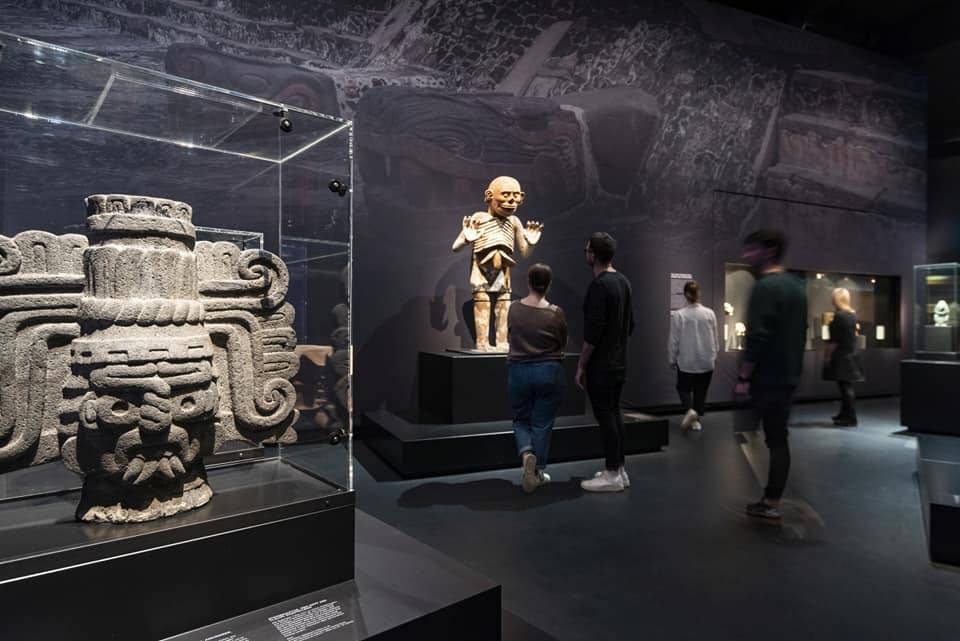
“Aztecs“ was an exhibition organized by the Linden-Museum Stuttgart in cooperation with the Nationaal Museum van Wereldculturen (Netherlands). The exhibition was under the patronage of Federal President Frank-Walter Steinmeier.
Sponsored by:
State of Baden-Wuerttemberg
In cooperation with:
Secretaria de Cultura del Gobierno de México , INAH, Museo Nacional de Antropologia (Mexico City), Museo Templo Mayor (Mexico City)
With kind support:
Sparkassen Finance Group
Media partner:
Damals – The magazine for history
In the 2019 summer semester, the Institute for Public Buildings and Design at the University of Stuttgart, led by Prof. Alexander Schwarz, addressed the question of the structural future of the Linden Museum. The fictitious task was based on the real-life idea of the intended new building.
Various locations in Stuttgart’s city center were discussed in terms of their potential for the ethnological museum. The respective urban disposition places specific demands on the museum designs and offers space for contemporary curatorial approaches.
In a concluding exhibition at the Linden–Museum, models and drawings of various design positions were presented. The designs, which were created with university freedom, were also intended to stimulate discussion about the significance of the Linden–Museum for the public urban space in the center of Stuttgart.
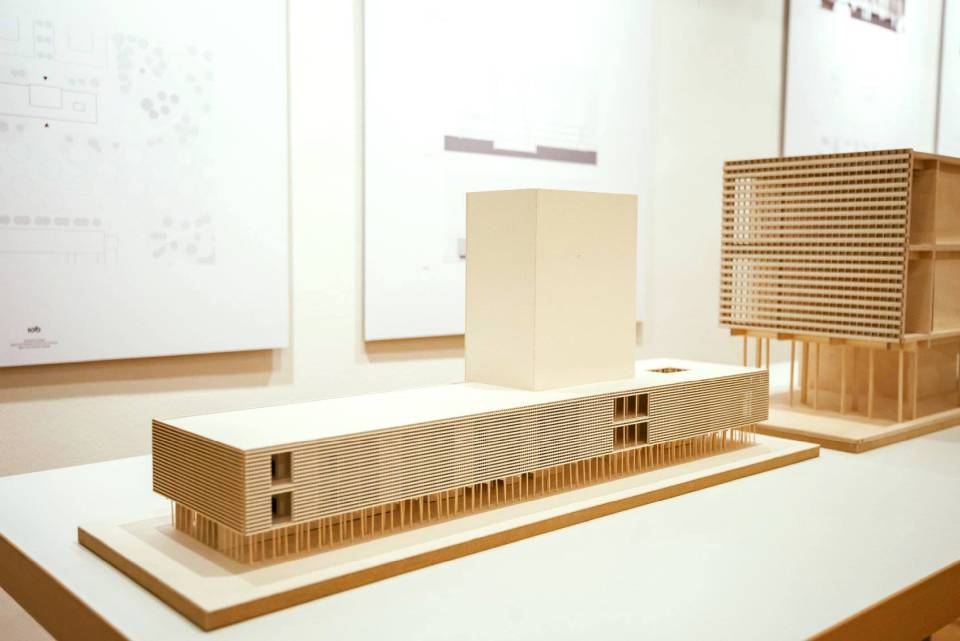
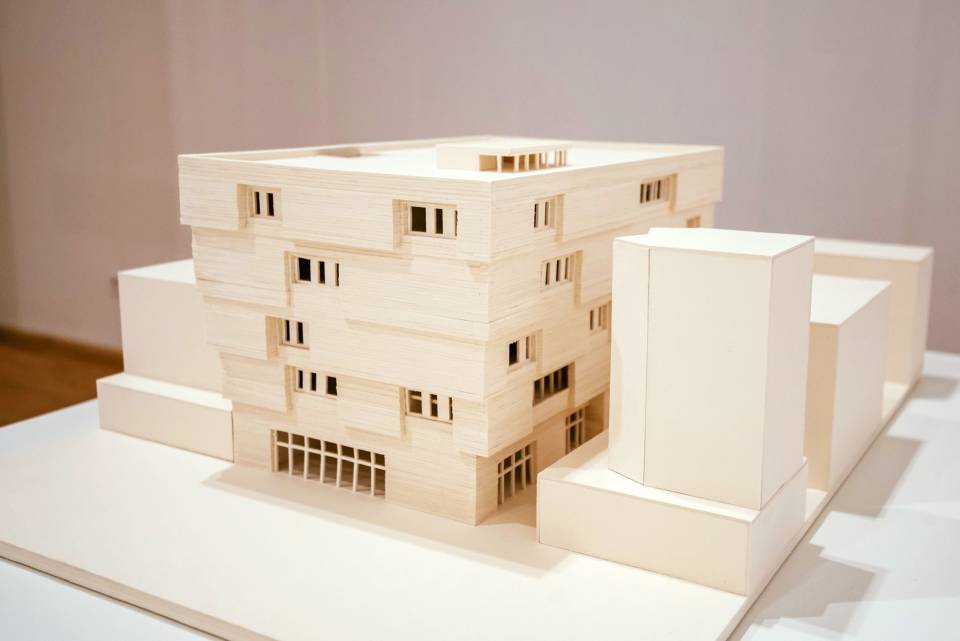
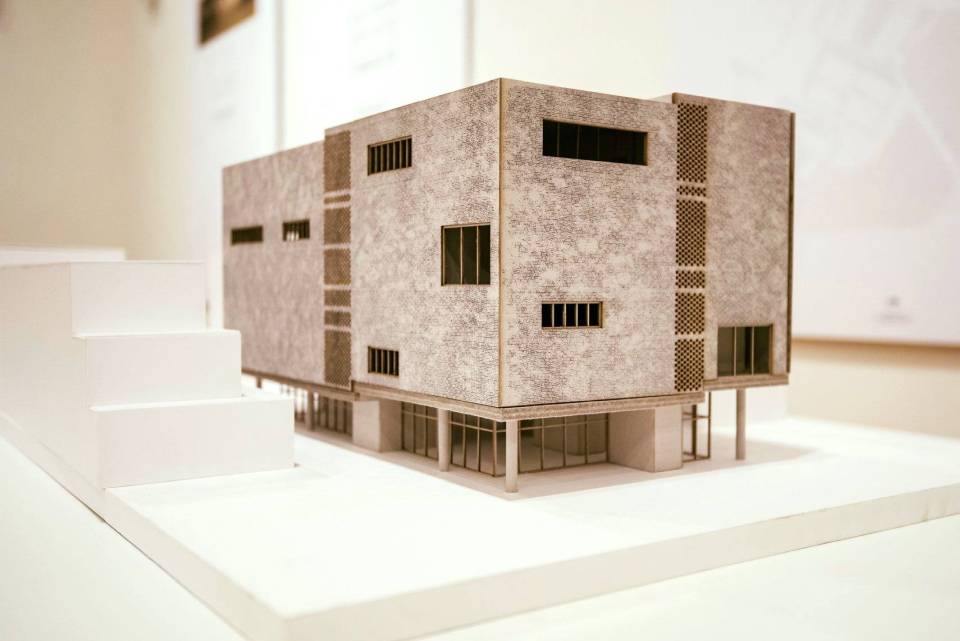
In cooperation with:
Institute for Public Buildings and Design at the University of Stuttgart
On February 28, 2019, the family Bible and whip of the Nama leader Hendrik Witbooi (1834-1905), which were donated to our museum in 1902, were returned to Namibia by the state of Baden-Württemberg. In the exhibition, the two objects were shown for the last time in the Linden-Museum.
“The question of how we deal with cultural assets and other objects in our collections that were acquired in a colonial context is increasingly being discussed – far beyond museums. The topic is also gaining relevance in society, because coming to terms with the past is always the starting point for understanding the present. Baden-Württemberg is therefore facing up to its historical responsibility. The return of the ‘Witbooi Bible’ and Hendrik Witbooi’s whip to Namibia is a significant signal and an important step in the process of reconciliation,” said Minister President Winfried Kretschmann in November 2018. The handing over of the Bible and the whip by the Minister of Arts Theresia Bauer to the Namibian President Hage Geingob will take place during a solemn ceremony, organized together with the Witbooi family, on February 28 in Gibeon. “For us, the restitution is at the same time the start of a joint reappraisal of the German-Namibian colonial history,” said Minister Bauer.
The return of the Bible and whip was the first restitution of colonial cultural assets from a museum in Baden-Württemberg. The Bible is of great symbolic and historical significance for Namibia.
Hendrik Witbooi was “Kaptein” during the German colonial period and one of the most important leaders of the Nama groups. Today, he is a national hero of Namibia and is commemorated by numerous monuments. The family Bible with handwritten annotations by Hendrik Witbooi and other family members was very likely captured in 1893 during an attack on Hornkranz, the headquarters of Hendrik Witbooi, by German colonial troops, who proceeded with the greatest brutality and also murdered many women and children.
Hawai’i has been a state of the USA since 1959 and has a very special history. Discovered and colonized by Polynesians more than 800 years ago, it was not until 1778 that Captain James Cook became the first European to reach the islands. Until 1893, the archipelago was a sovereign kingdom, whose last queen was overthrown in the face of fierce opposition from the Hawaiian people. Regaining the lost independence remains an important long-term political goal for many Hawaiians.
In the exhibition, contemporary works by Hawaiian artists met unique objects from the 18th century from the Cook/Forster Collection of the University of Göttingen – current explorations of the Hawaiian present and future were combined with a look into an important past.


What does it actually mean to be at home in Stuttgart? Which things, feelings and people belong to it for me? How is it possible to live well together? Are the objects “at home” in the Linden-Museum? Based on the initiative of the artist Patricia Thoma, who has been painting pictures with children on the topics of home, diversity, migration and homeland for several years, several groups dealt with these questions. Their search for clues, ideas and answers found artistic expression in different ways. Children from Stuttgart elementary schools created pictures of their own homes with Patricia Thoma and at the same time dealt with everyday things from the collection of the Linden-Museum.
The youth club of the Linden Museum went on a city exploration and put together a Stuttgart collage. Young people from the Society for Open and Mobile Youth Work – Cannstatter INZEL critically examined the objects in the museum and sought forms of expression to make their thoughts visible. Students of the Merz Akademie accompanied and commented on this process artistically and medially together with their lecturer, the artist Ülkü Süngün, from a postcolonial perspective. As part of the intercultural children’s festival on June 17, 2018, children designed pop-up cards of their rooms, which were presented as photos in the exhibition.
In the exhibition, the children and young people presented a diverse picture of their city and explored what they believe makes a good life together. At hands-on stations, all visitors were able to create their own image of a diverse city.
The Linden-Museum Stuttgart followed an intersectional and transcultural approach in the work phase for the exhibition and worked with anti-bias methods, dialogical learning methods, and artistic techniques to raise awareness of power structures and avoid their reproduction.

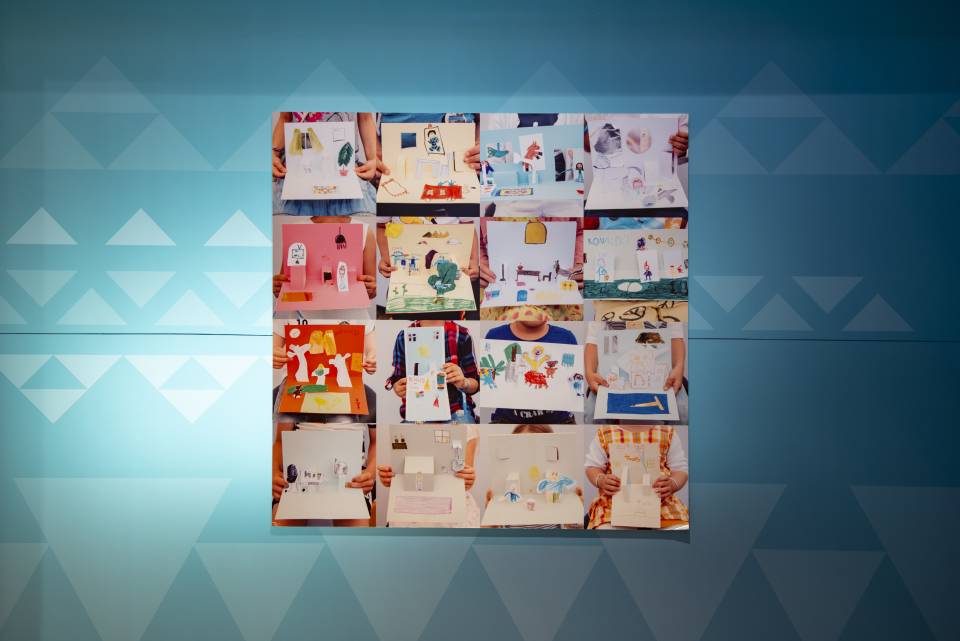
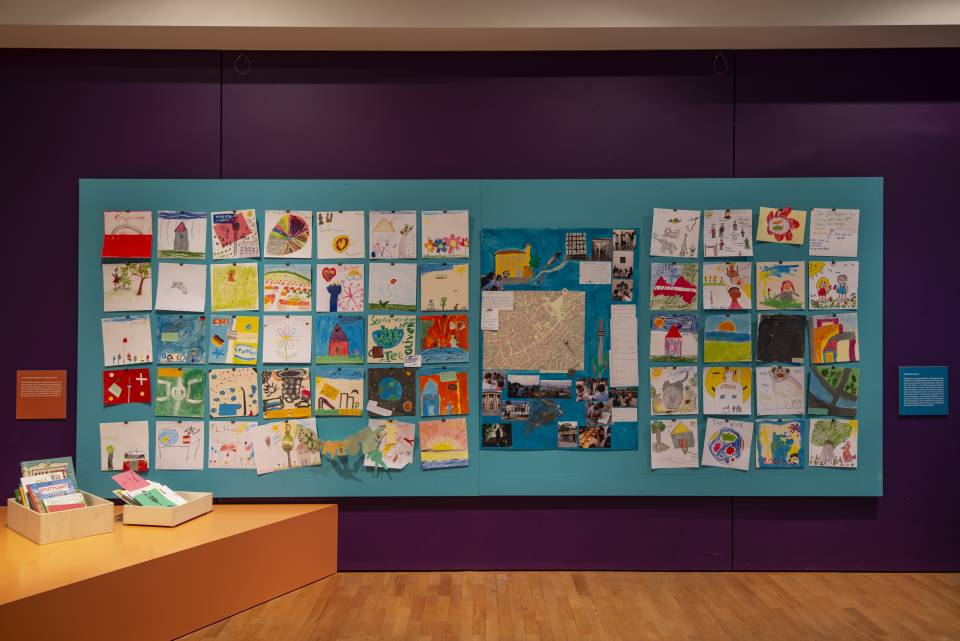
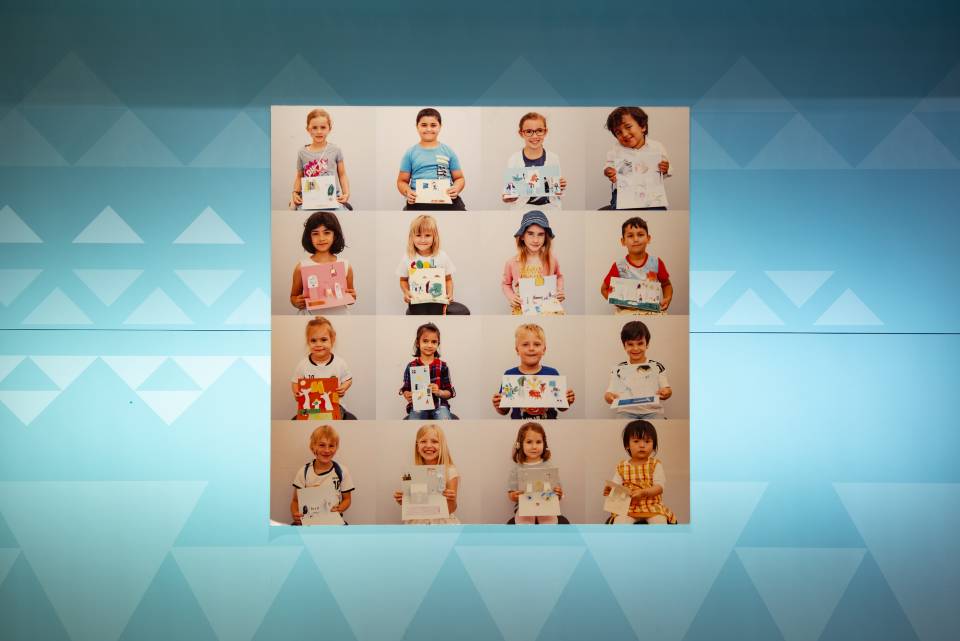



In cooperation with:
State Center for Political Education Baden-Württemberg
In the framework of SWICH – Sharing a World of Inclusion, Creativity and Heritage, Co-funded by the Creative European Programme of the European Union.
For the first time in Germany, the large special exhibition of the state of Baden-Württemberg focused on the art and culture, history and present of the Hawaiian Islands. Impressive works of art and everyday objects gave an insight into life on those islands, whose society changed from a Polynesian kingdom to a modern state in less than 150 years.
The exhibition ranged from the oldest surviving objects from the time of the explorer James Cook, who landed on Hawai’i at the end of the 18th century, to today’s lively art scene. It conveyed a multifaceted picture and emphasized the society, culture and history of the Native Hawaiians.
The Polynesian society and the social and political upheavals caused by the economic and power interests of the USA were discussed. The exhibition asked about the origin of the objects and took a critical look at the image of Hawai’i that was created in Europe. Valuable feathered coats and helmets of the nobility, everyday objects such as fishing hooks and vessels, printed fabrics made of bark bast or sculptures testify to great craftsmanship. Historical developments were related to current ones: the invention of surfing with the famous surfing competitions, modern variations of the narrative hula dance with traditional rhythm instruments, music and art as a critical examination of social injustice, environmental destruction or as an expression of the independence movement.
Around 250 high-caliber objects from international lenders and from the Linden-Museum collection were presented in atmospheric displays over an area of 1000 square meters.

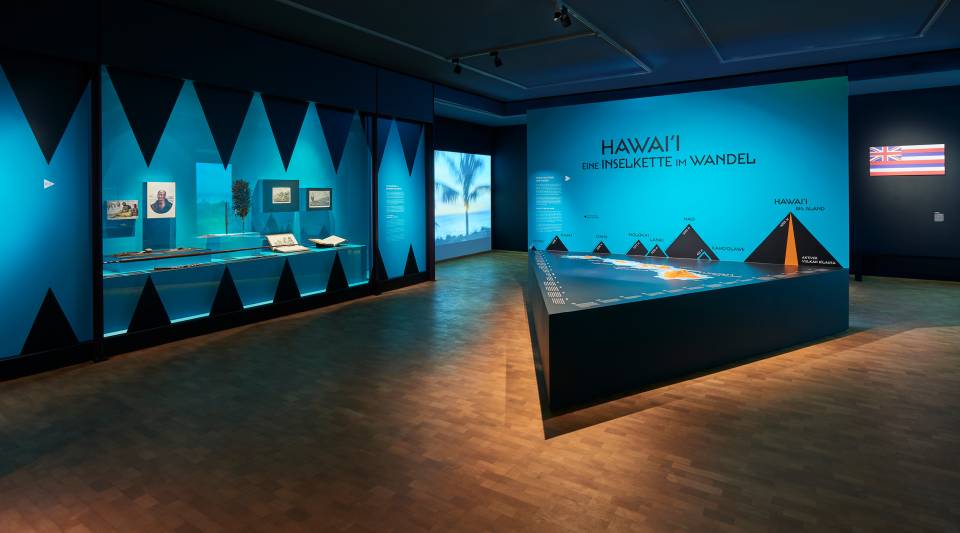
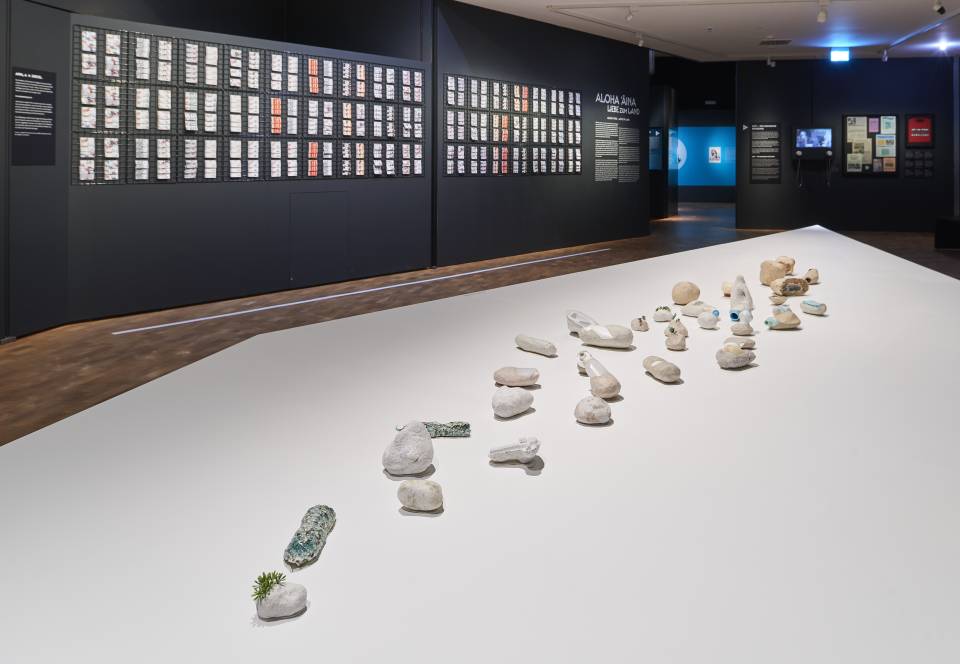
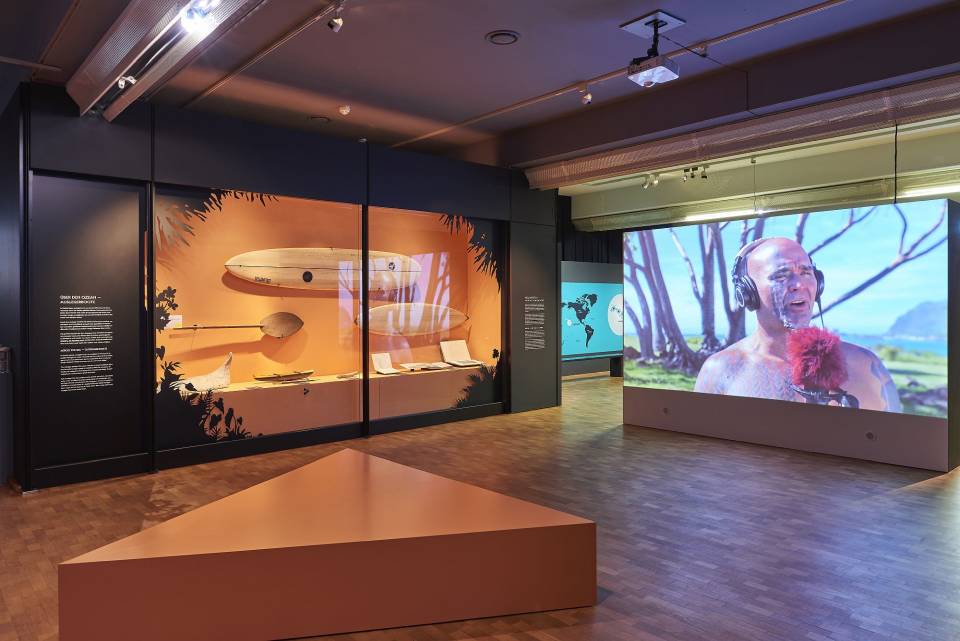
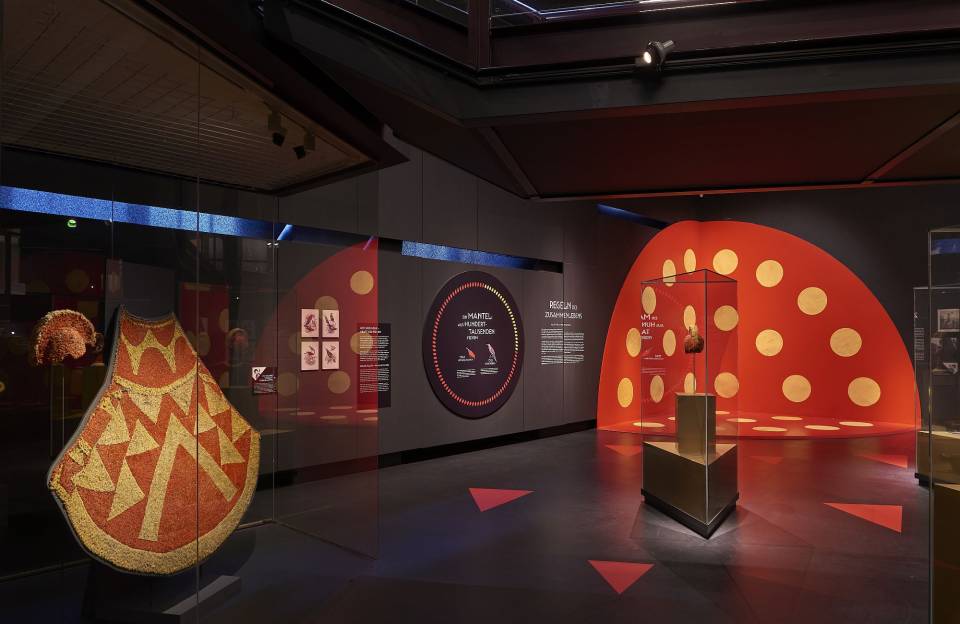
Action booklet and Hawai’i game for kids
For children, there was a free activity booklet “In the middle of the sea” to accompany the exhibition: Leilani and Keanu talk about life on the islands and set tricky tasks. The booklet was made possible by the Gesellschaft für Erd- und Völkerkunde e.V.
There was also a smartphone game that guided visitors through the Hawai’i exhibition: “Aloha – Kekoa’s Journey” was developed by students at Stuttgart Media University as part of the “Code for Culture” project of the Medien- und Filmgesellschaft Baden-Württemberg and could be played in the exhibition.
Large exhibition of the state of Baden-Württemberg
Funded by:
Ministry of Science, Research and the Arts Baden-Württemberg
Media partner:
National Geographic
Porcelain is one of the great Chinese inventions. At the same time, the beauty of the pottery is based on the perfect interplay of shape, glaze and decoration. Where decorations are omitted, the focus is entirely on the simple elegance of the colored cover.
By the end of the imperial period, Chinese potters, through their extensive knowledge of clay, glazes, and color bodies, as well as their masterful control of firing conditions, had succeeded in producing colors reminiscent of the bright blue of a clear sky, red, delicately speckled bean seeds, or the shiny polished surfaces of bronze mirrors. The pottery masters of the Qing period (1644 – 1911) used the classical ceramics of the Song period (960 – 1279) or the monochrome glazed porcelains of the Ming period (1368 – 1644) as models, but at the same time they also developed new, unusual colors to meet the demanding wishes of their clientele, especially the imperial court. Influenced by the prevailing preference for antiquities, some of her vessels were created in imitation of antique bronzes.
The fascinating color palette and the variety of shapes of these late monochrome porcelains are exemplified by the Dr. Georg Büchner Collection, from which the Linden-Museum Stuttgart presented a representative selection for the first time as a cabinet exhibition.

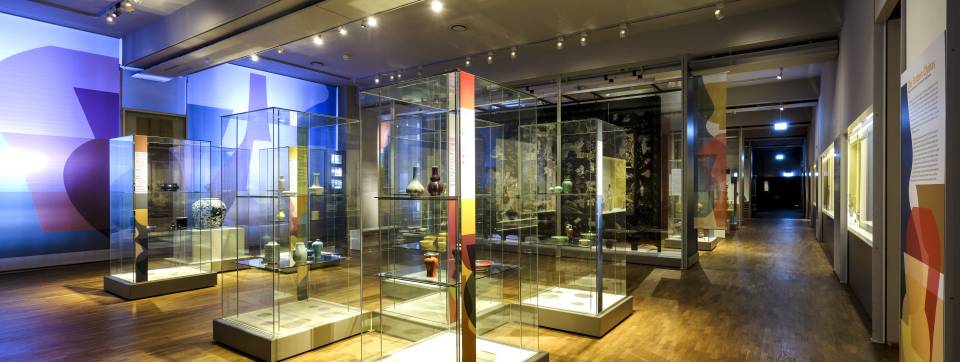
“Oishii!” – “I like it!” – is the most common word in Japan to indicate good taste at the dinner table. It is an expression that goes hand in hand with the social and cultural identity of the eater. Because food is much more than nutrition in Japan. It is connected with all spheres of human life and provides a view of the most diverse aspects of society.
Against this backdrop, we dedicated a large special exhibition to Japanese eating and drinking culture. The exhibition focused on the cultivation of rice and its importance for Japanese society, the “sacred drink” sake, the role of fish, seafood and seaweed as well as vegetables, noodles and condiments in the kitchen. The world of tea traditions (chanoyu and sencha), the culture of picnics and bento were also addressed. How have eating habits changed throughout history? What complex technological services are required for the extraction and preparation of food? Who eats what when? The exhibition traces all of these questions, at the same time directing our gaze to a rich material culture and encouraging us to become (more) aware of our own food habits.
Originals from the museum’s own collection were presented, ranging from ink and woodcuts to ceramics, including valuable objects that have never been shown before. These were supplemented by loans from Germany and abroad. Multimedia elements bridged the gap between the historical exhibits and the present and also brought Japanese voices into play.

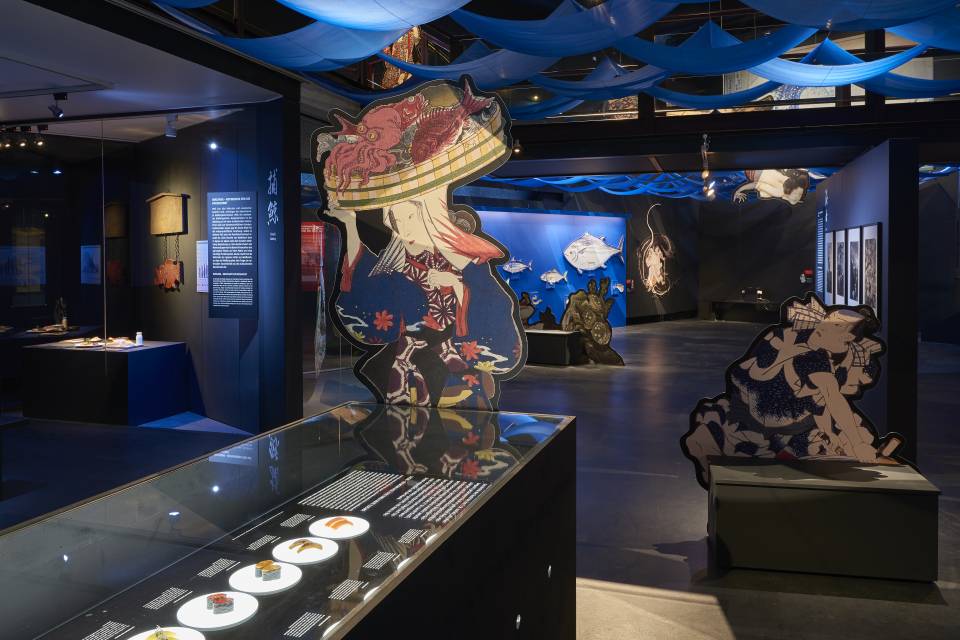
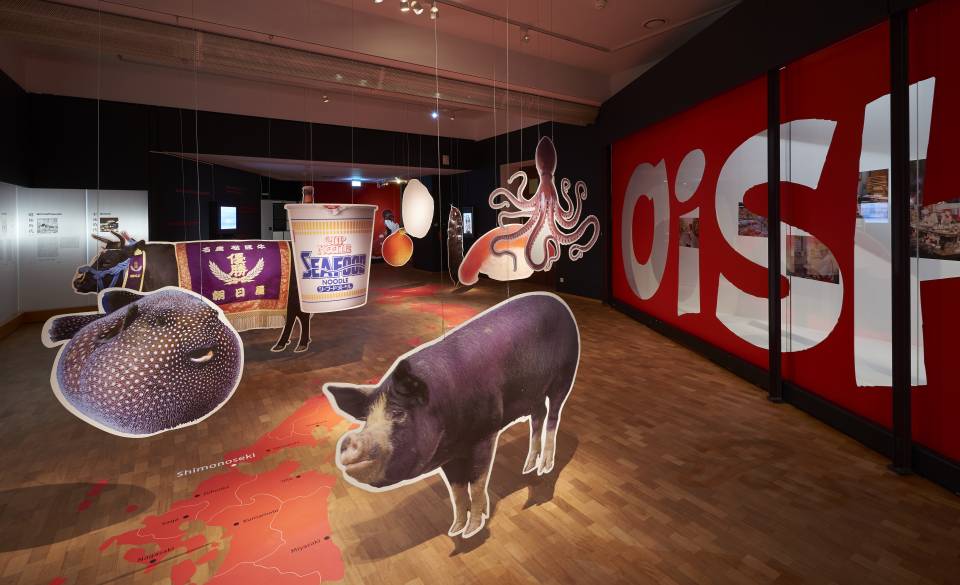
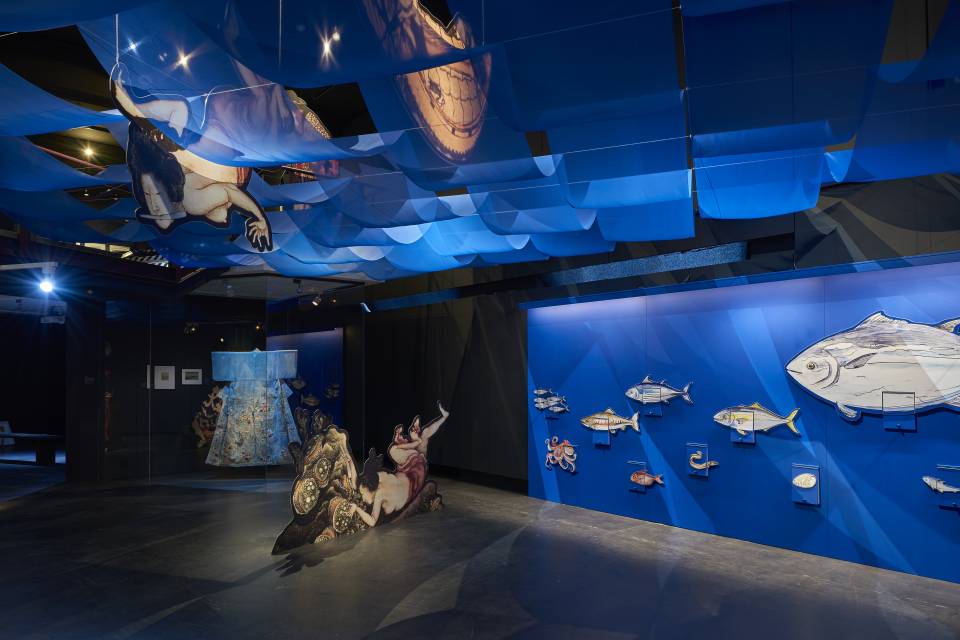
Children’s booklet: With Yuki through the exhibition
Yuki shows in the children’s booklet what is eaten and drunk in her home country. She talks about her favorite dishes, why samurai were given rice as food, picnics under cherry blossoms, and the tea ceremony. How to eat with chopsticks? What do you take in the bento? And how did it happen that the fisher boy fell in love with the sea princess? The activity booklet invited people to take a closer look and solve puzzles and tasks. The activity booklet was made possible by the Gesellschaft für Erd- und Völkerkunde e.V. and was handed out free of charge to all children at the ticket desk.
Main sponsor:
Trumpf
Media partner:
G/Geschichte
Inrō – small multi-part containers for seals and medicines that were attached to the belt with the help of a toggle (netsuke) – came into use in the 16th century and remained a conspicuous accessory of Japanese men’s fashion until the end of the 19th century. The symbolic, not infrequently narrative decorations provide valuable insights into Japanese culture. The inrō, which are mostly crafted in lacquer with care and attention to detail, are still very popular among collectors today.
The cabinet exhibition showed part of the Linden-Museum’s extensive Inrō collection in the East Asia department together with a large selection of netsuke.
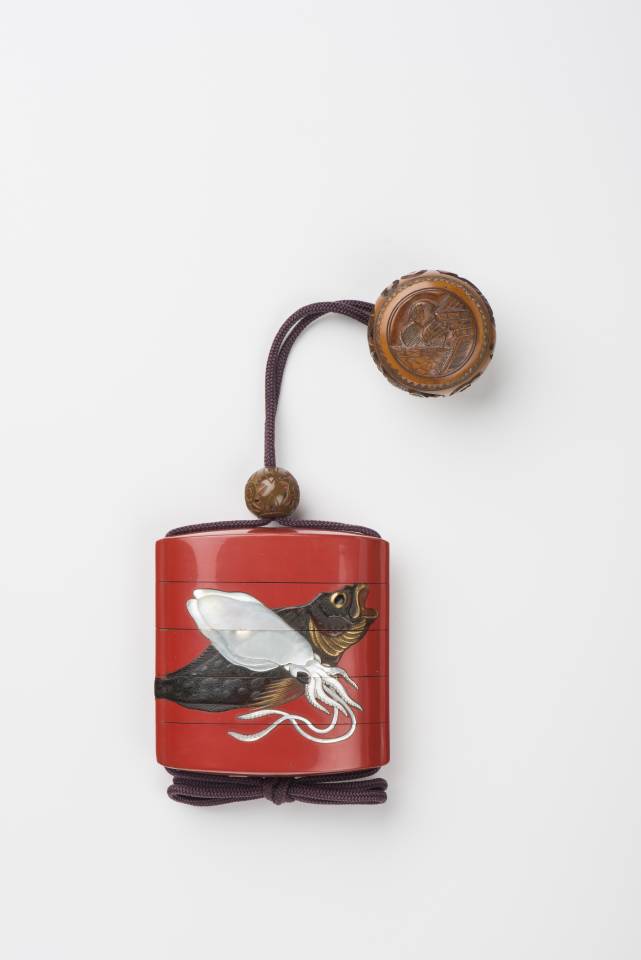
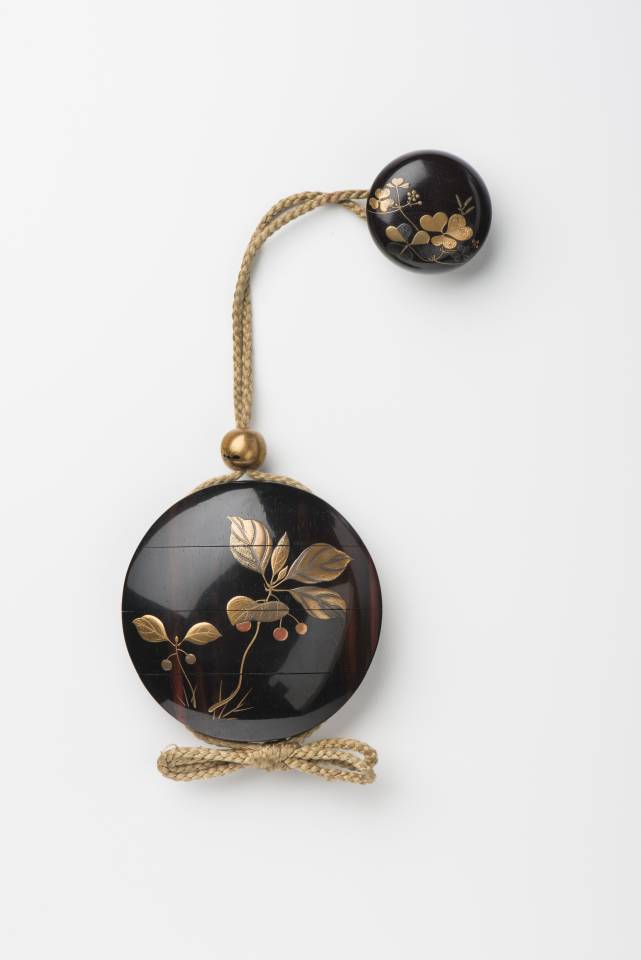

With kind support:
Trumpf, Berthold Leibinger Foundation
The mysterious interplay of light and shadow has captivated people since time immemorial. As cultural expressions of this fascination, rich traditions of shadow theater have developed, especially in Asian countries such as China, Indonesia, and India. The exhibition used top-class collections to show the close links between the shadow theater traditions of Asia, the Orient and Europe.
In addition to the similarities in performance principles, aspects of storytelling or the typology of characters, regional characteristics of shadow theater came into focus: In India, Java and Thailand, shadow theater is also a ceremonial act in the context of temple festivals, tells great epics such as the Ramayana and is still part of cultural identity today. In China, it incorporates elements of Chinese opera such as music, costumes and masks and becomes a total experience in artistic perfection, while in the Orient it was above all a mirror of society, uniting the audience in shared laughter with great wit and humor.
The exhibition featured previously unseen pieces and rediscovered treasures from the Linden-Museum’s collection. Worthy of mention are the old stocks of Southeast Asian figures, the Chinese figures of the Eger Collection and the unique Egyptian figures of the Kahle Collection – the oldest known shadow puppets of the Islamic world. More recent collections such as the Indian figurines from the Seltmann Collection and the Turkish figurines by the well-known master Ragıp Tuğtekin (1891 – 1982) complemented these old holdings on an equal footing.
The artistic mastery and aesthetic quality of the impressive shadow puppets, which inspired artists such as Franz Marc and still fascinate today, became visible. The enthusiasm for shadow theater in Europe, which reached a final climax in the first third of the 20th century, and the further development of contemporary shadow theater, represented with loans from the International Shadow Theater Center Schwäbisch Gmünd, were also topics of the exhibition.
Atmospheric productions brought narrative traditions to life and combined them with music, song, images and film. Hands-on elements on the “Fascination of Shadows” offered young and old an exhibition experience for all the senses. The exhibition was framed by a multifaceted accompanying program.
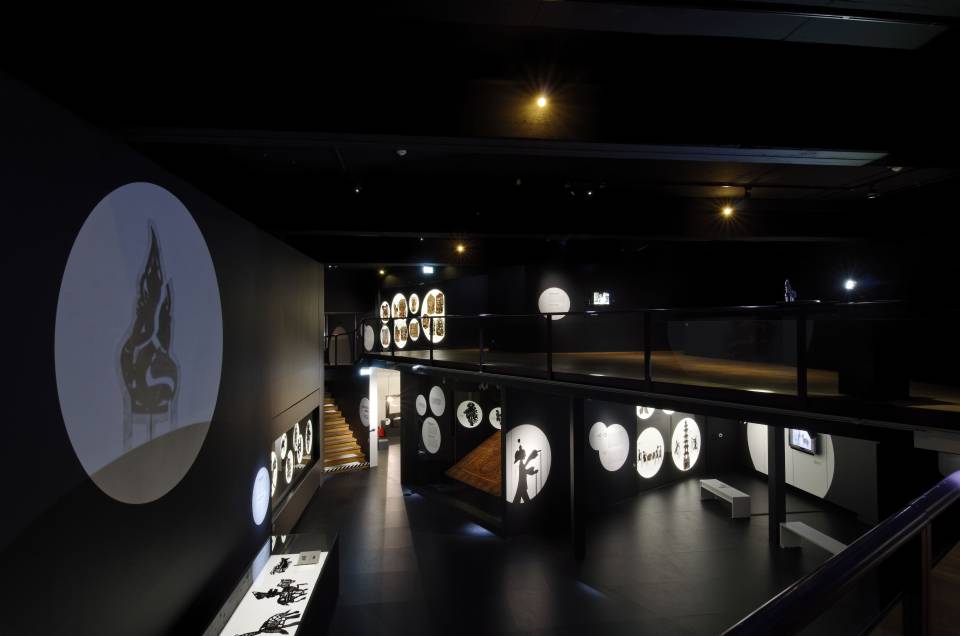



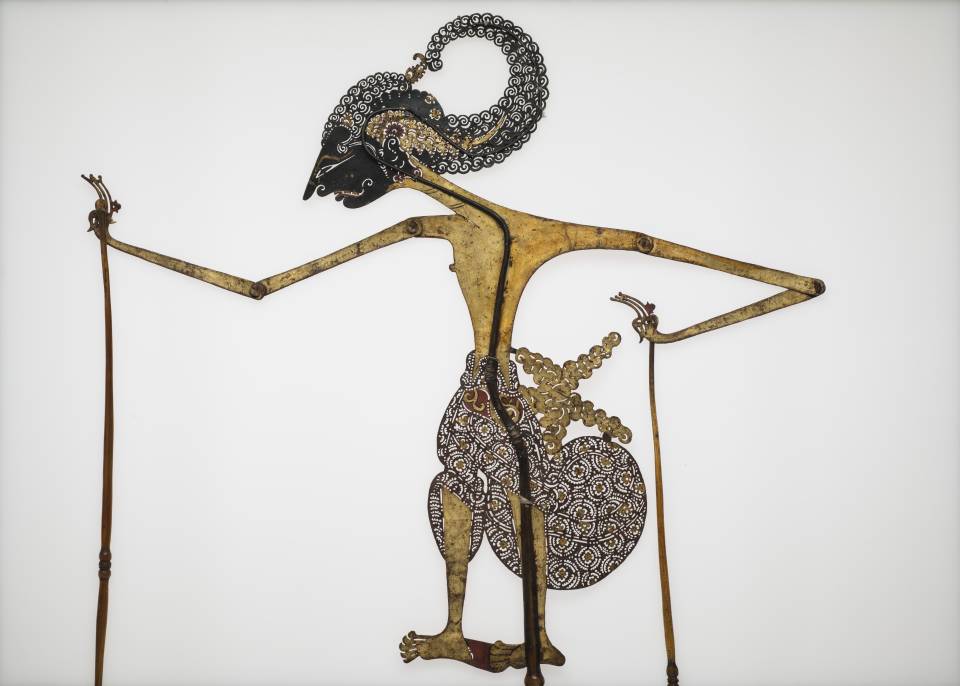



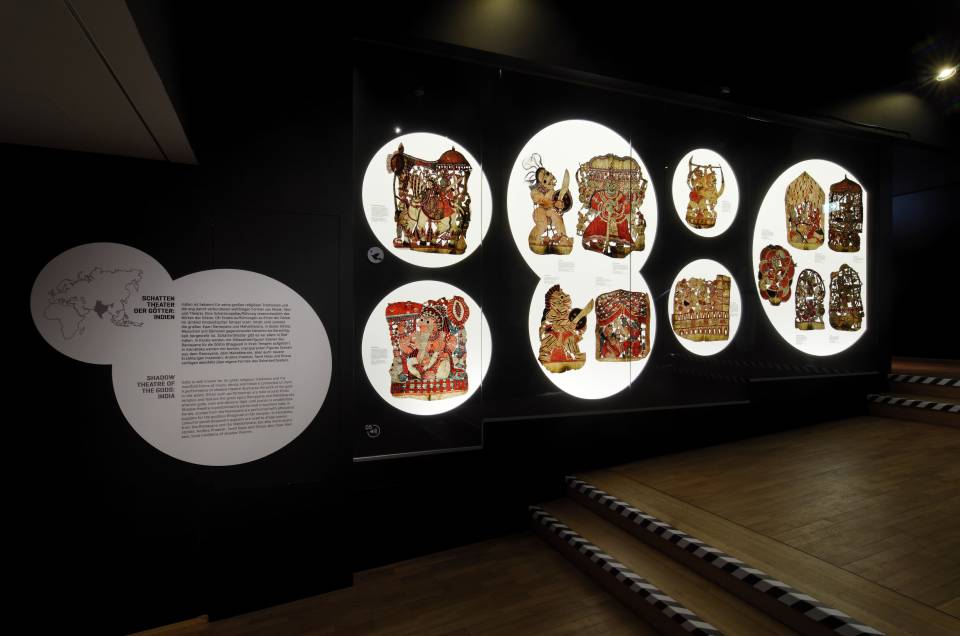
Participation desired
In the shadow laboratory, children and families got their money’s worth by drawing silhouettes, experimenting with overhead projectors or playing on a small stage. How do I conjure up a dog with my hands? And what is behind the story of the “garbage monster”?
Children’s booklet
The popular campaign booklet was once again available free of charge at the cash desks. Children from the age of 8 got to know Flux here. The colorful bird flutters through the stages, chirps details worth knowing, introduces the children to his friends and poses tricky tasks that promise a little surprise if solved correctly.
Under the patronage of the German UNESCO Commission e.V.
Cooperation partners of the exhibition are the International Shadow Theater Center and the 10th International Shadow Theater Festival Schwäbisch Gmünd.
With kind support:
Deutsche Bahn
Media partner:
G/Geschichte
Myanmar – the mysterious “Golden Land”: Although Myanmar, formerly Birma, is one of the larger countries in Southeast Asia with an area of 678,500 km² and a population of around 55 million, its culture, art and history are largely unknown. The exhibition provided comprehensive insights into the culture of a country that is making its way into the modern age after many years of isolation.
Anyone who travels through Myanmar immediately recognizes: life there is determined by Buddhism. Centuries-old temples and golden pagodas dominate the landscapes, in every house a shrine is enthroned in the highest place for the daily worship of Buddha and children become monks at a young age.
Using 200 selected originals from top-class international collections, films and music, the exhibition conveyed an impression of Myanmar society and traced the diverse forms of expression of lived religion. The focus was on Myanmar Buddhism and the closely related arts. On display were a throne, impressive Buddha figures from twelve centuries, frescoes, magnificent manuscripts on paper, palm leaf and ivory, filigree wood carvings, lacquer vessels and other objects from Buddhist monasteries. The performing arts also contributed to the communication of Buddhist teachings. In addition to excerpts from performances, costumes, puppets and traditional musical instruments were on display. The highlight was a complete Hsaing orchestra, which consists of a variety of different drums, gongs and other melodic instruments and is used at public events to accompany dances and religious ceremonies.
Astrology and magic still play an important role in Myanmar today. The worship of the Nat spirits is presented in a complete shrine with figurines and votive offerings. Traditional moral concepts and the belief in the effect of colors and patterns, which can have a lasting impact on one’s fate, characterize the arts of body design: The exhibition showed fine silk dresses, hand-woven cotton fabrics, jewelry, traditional cosmetics and tattooing utensils. Works by contemporary artists finally set out in search of a Myanmar modernity.
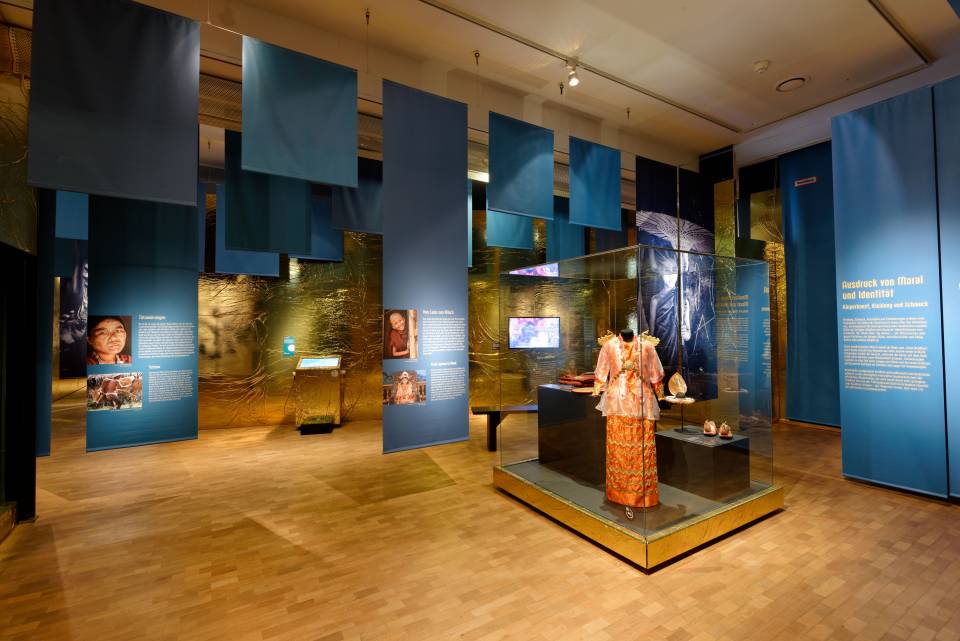
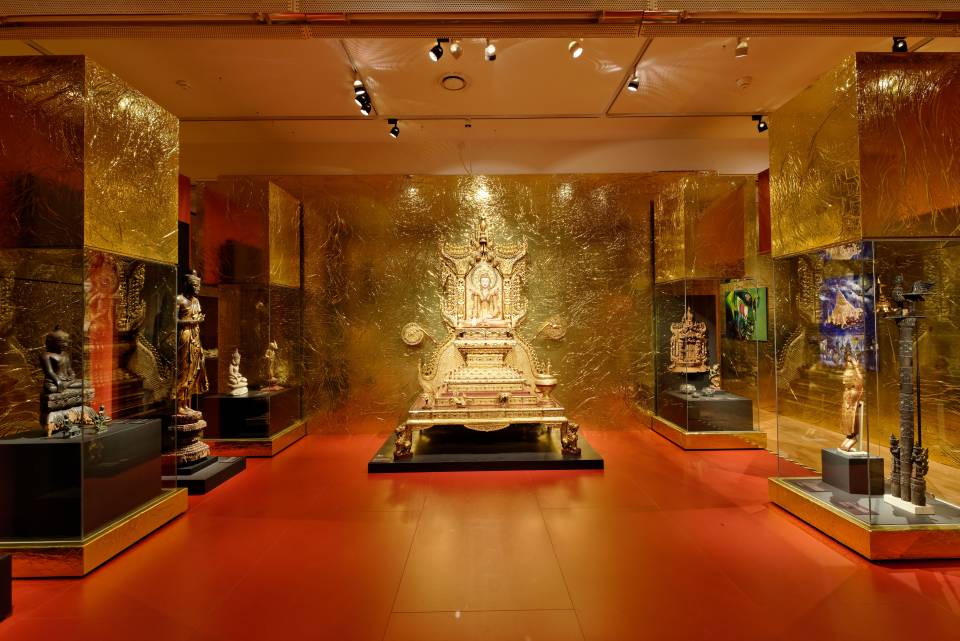
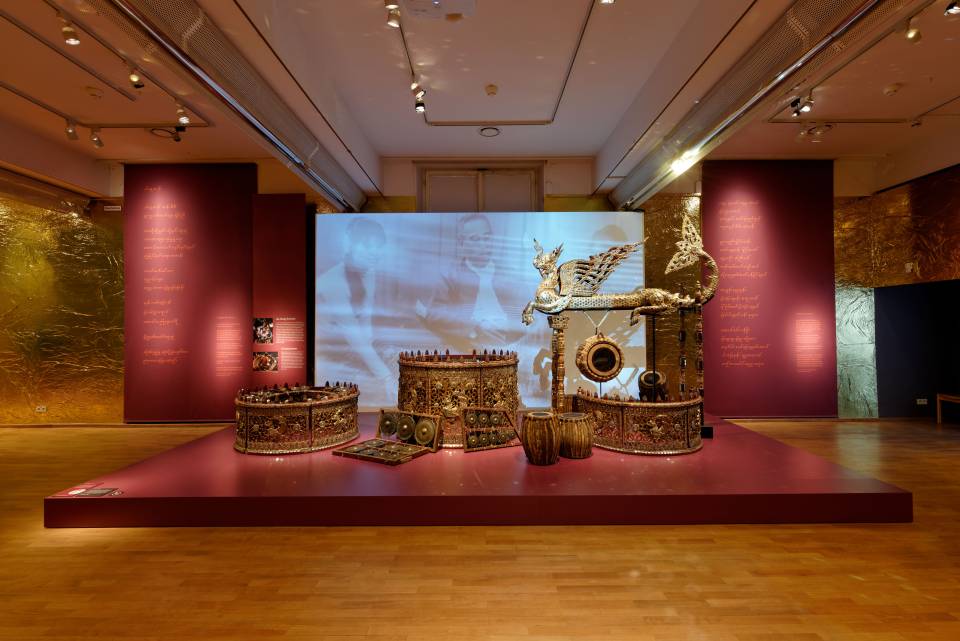
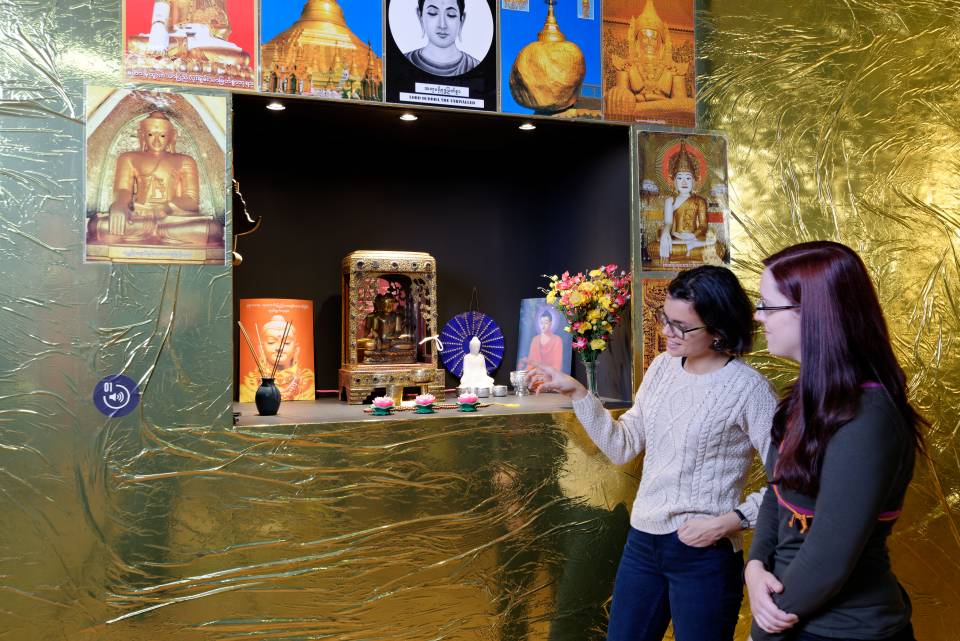
For kids
Embedded in the exhibition was a special children’s level: young visitors discovered his home together with the little monk Dhammananda. He tells about monasteries, mythical animals and their planets, and shows how to dress and what the writing looks like. A free children’s booklet accompanied visitors through the exhibition, with stations inviting them to try things out and be amazed.
Lenders:
Museum der Kulturen Basel / Museum Rietberg Zürich / Staatliche Museen zu Berlin, Museum für Asiatische Kunst / Staatsbibliothek zu Berlin – Preußischer Kulturbesitz, Orientabteilung / Pitt Rivers Museum, University of Oxford / Völkerkundemuseum der J. G. E. von Portheim-Stiftung Heidelberg / Pansodan Gallery Yangon / Yangon Film School / Private loans
Mobility Partner:
Deutsche Bahn
With the kind support of:
State of Baden-Württemberg, Ströer – Deutsche Städte Medien
Media partner:
National Geographic
Dienstag bis Samstag, 10 – 17 Uhr
Sonn- und Feiertage, 10 – 18 Uhr
Ausstellungen
Sonderausstellungen
Dauerausstellungen